Review: Saints Row The Third
 Friday, November 11, 2011 at 5:25PM
Friday, November 11, 2011 at 5:25PM 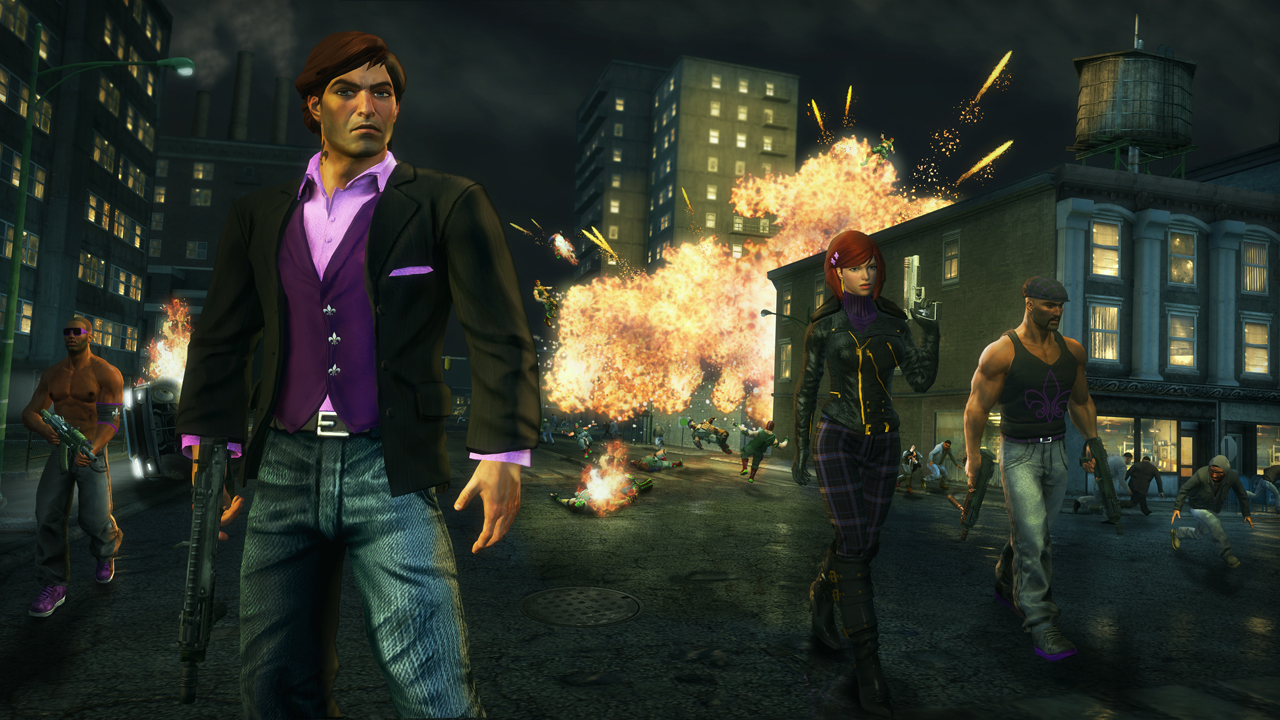 Volition Inc. has always been a curious case for me when it came to their line-up of titles. I enjoyed the Red Faction series as well as their exceptional work on FreeSpace 1 & 2 but I didn’t get into either of the Summoner titles. When the Xbox 360 launched in 2005 Volition was presented with an incredible opportunity. Since Rockstar Games had gone silent to work on their Rage engine and what would become Grand Theft Auto IV there was nary a next generation open-world title to be found, something fans had been craving since GTA San Andreas. The result was Saint’s Row, Volition’s first outing into a sandbox title. The game did well commercially and was cited as what fans could play to tide them over until the next GTA title was announced. Saint’s Row 2 picked up where its predecessor left off and completely jumped the shark, ditching any sort of melodrama in favor of over-the-top gameplay ideas like the Septic Avenger, sing-alongs, and a strong cooperative element.
Volition Inc. has always been a curious case for me when it came to their line-up of titles. I enjoyed the Red Faction series as well as their exceptional work on FreeSpace 1 & 2 but I didn’t get into either of the Summoner titles. When the Xbox 360 launched in 2005 Volition was presented with an incredible opportunity. Since Rockstar Games had gone silent to work on their Rage engine and what would become Grand Theft Auto IV there was nary a next generation open-world title to be found, something fans had been craving since GTA San Andreas. The result was Saint’s Row, Volition’s first outing into a sandbox title. The game did well commercially and was cited as what fans could play to tide them over until the next GTA title was announced. Saint’s Row 2 picked up where its predecessor left off and completely jumped the shark, ditching any sort of melodrama in favor of over-the-top gameplay ideas like the Septic Avenger, sing-alongs, and a strong cooperative element.
It’s been three years since we last saw the Third Street Saints but they are back in action and are more over-the-top than ever. Against one of the most crowded holiday line-ups in gaming history though can it hold its own?
Click to read the full article
Review: The Elder Scrolls V: Skyrim
 Thursday, November 10, 2011 at 7:02AM
Thursday, November 10, 2011 at 7:02AM 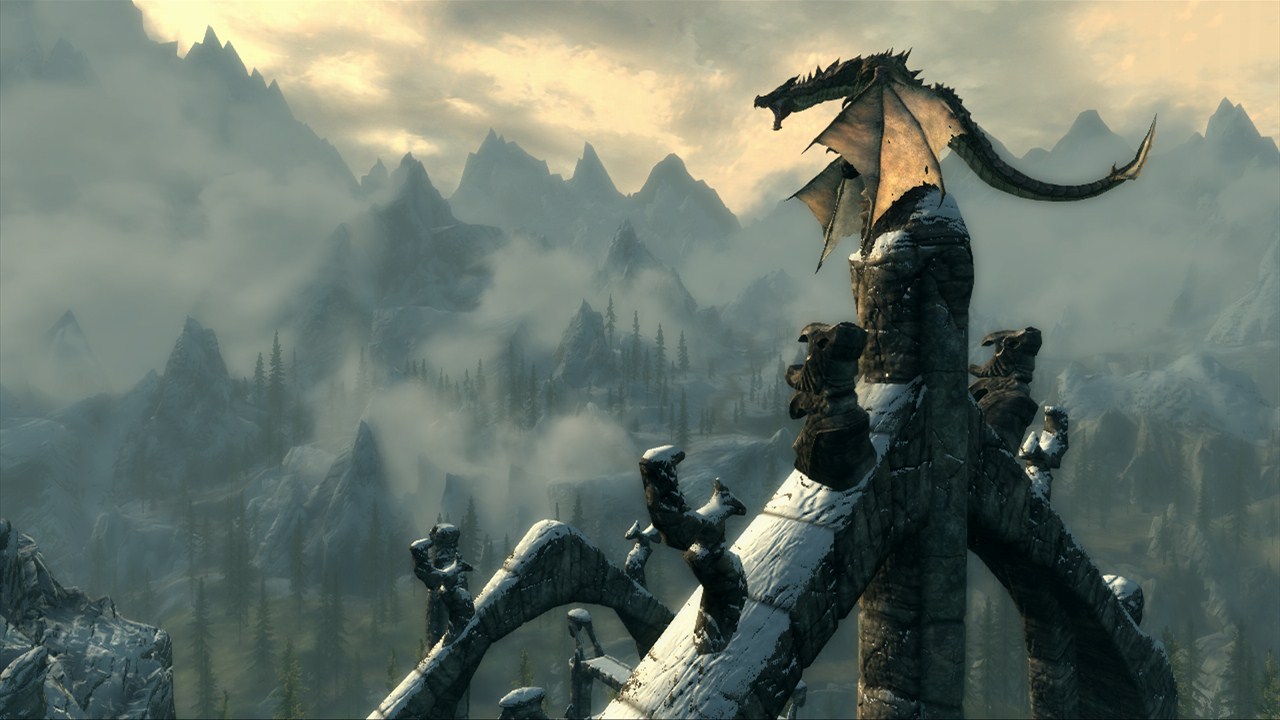
High fantasy is one of the most popular genres across every medium. For each type of entertainment there are household names that have stood the test of time and continue to dominate long after they first arrived on the scene. The premiere author for high fantasy these days is George RR Martin while Peter Jackson’s work on the Lord of the Rings trilogy has dominated cinema for a decade. In the world of video games however the competition is far fiercer but amidst such strong competitors as Diablo and Baldur’s Gate there has been and continues to be only one true champion: The Elder Scrolls. When the forth title in the series, Oblivion, arrived in 2006 it blew the critics and consumers away with an incredibly in-depth world full of intrigue and adventure with enough content out of the box to last well over 100 hours.
Bethesda Softworks took a break from the series to release Fallout 3 in 2008 but has returned to their roots with Skyrim, taking us to lands previously unexplored. With a five year wait between Elder Scrolls titles and a vastly different release in the interim is The Elder Scrolls still the series fans have loved for well over a decade or has Bethesda’s post-apocalyptic juggernaut changed the series forever?
Click to read the full article
It Dawns In Fire
Two hundred years have passed since the gates of Oblivion opened up across Cyrodiil, flooding the countryside with the evil Daedra. With the end of the Oblivion Crisis the Forth Era began, an age of peace and rebuilding meant to restore the Empire to its former glory. As time has gone on however the Empire has instead begun to crumble as it is losing its grip on the northern province of Skyrim, home to the Nords and refuge to a strong portion of the Elven and Orc populations. Skyrim is on the brink of civil war between the Imperial-backed Loyalists in Solitude (Skyrim’s capital) and the Stormcloak rebels of Windhelm. And, once again, the Elder Scrolls have predicted this and the terrible repercussions are beginning to take hold.
You awaken on a cart being taken to your execution for attempting to cross the border into Cyrodiil. In the middle of it however an awesome and dreadful sight arrives: a dragon. Long thought extinct, you are barely able to escape the beast as it tears apart the town’s motley garrison. From here your destiny is your own to make but the Elder Scroll’s prophecies will be fulfilled whether you will it to or not. The survival of Skyrim and all of Tamriel is in your hands but the outcome is a fate of your choosing.
Skyrim’s story, much like that of Oblivion, is an open-ended affair that can’t be so much told to you as experienced. Given the nature of Bethesda’s catalog of titles this is to be expected but to spoil anything from the story would be blasphemous. What I will go over however are some of the sections as examples as to what the player can do without invading the main storyline. What I can say is that of the overarching narrative is that, while perhaps not in possession of the best narrative in comparison to some great games out there you will find yourself having trouble both leaving and returning to the main plot as there’s simply so much to see and do in Skyrim. When looking at Bethesda’s previous efforts however the answer is clear: Skyrim is the best one so far.
Men are But Flesh and Blood
Like all other titles Bethesda has created since they were first formed Skyrim has a rather robust and complex character creation system. At the beginning of the game you are allowed to create whoever you wish to be across a choice of ten races, each with their own native abilities like magicka resistance or enhanced thievery skills. While each one has unique enhancements you’ll also find that being a certain race can give you access to different conversation possibilities and even alter the way you are viewed in Skyrim. For example, since the Nords that dominate the population of the province are quite racist to Orcs and Elves you can find yourself being insulted and possibly more if you are not careful. As an Orc however you will automatically have access to a few Orc strongholds that lie throughout Skyrim. This mechanic does not seem to limit the player access to anywhere in the world however so you don’t have to worry about which race you choose. Given that you are Dovahkiin I felt it necessary to include a little humor in the background of my character. Thus Dvorak, the female Imperial, was born and for those of you who got that joke I send your way a high five.
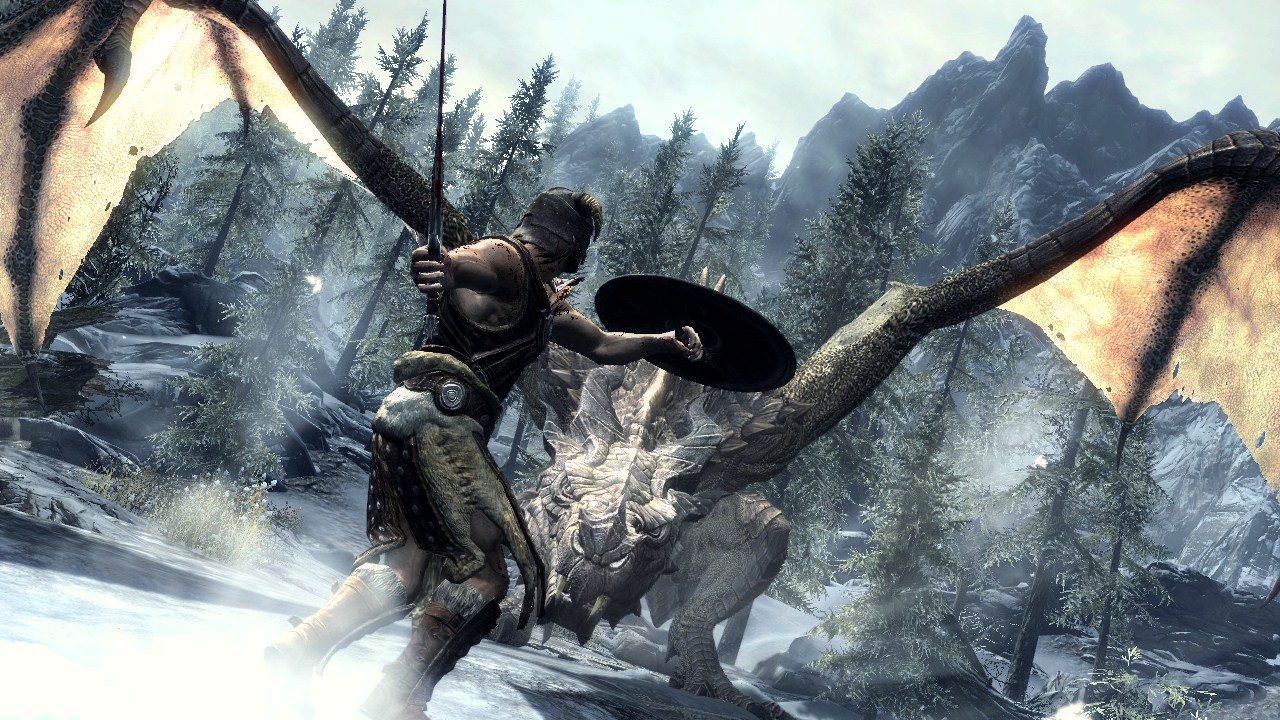
Character leveling and upgrading is a staple of any role playing game and Bethesda titles are no exception. What you will find however is a far different system from all the other titles before Skyrim. Instead of choosing which skills to give stat-building points to this time around the entire system has been redone. No longer will you gain experience for completing quests. Instead you will earn an overall level by completing leveling of the various skills at your disposal. The eighteen different skill sets are divided into one of three categories: Mage, Warrior and Thief. There are no acrobatic or mysticism skills in Skyrim so don’t think you can just go running and jumping across the countryside to level up your character. Sorry, this time you have to earn it if you want to reach the game’s level cap of fifty.
Within those eighteen skill sets you will find another new ability: perk activations. Similar in concept to the system utilized in Fallout 3, each skill set contains a perk tree that gives you access to more powerful ones if you can both unlock the preceding ones in the path by continuously leveling that skill. Using the archer skill set you can, for example, unlock the ability to zoom in and slow down time when drawing your bow. Others, like the smithing skill, allow you to create and upgrade various different types of armor and weapons depending on your how much you level it. The ability to unlock a perk comes available each time you have leveled up your character but you are not required to unlock one during this process. Perk saving is a welcome addition to the series and I can only hope it sticks around.
Unlike Fallout 3 though, whatever character you choose, you will find that Skyrim returns to the tradition of allowing you to max out your character in all aspects rather than having to rely on specific specializations. To do so however is a triple digit investment of hours so those daring enough (and have that amount of time on their hands) can certainly have their cake and eat it too. Regardless of whether you are willing to invest that kind of time into the game you’ll still find yourself more in control of your character than ever before.
They Know Their Doom, But not the Hour
I have made it clear in the past that I believe that only one game has ever done first-person melee combat right, that title being Condemned: Criminal Origins. Condemned’s mix of simple, strike and block mechanics made combat both easy to understand and at the same time quite intense. In Oblivion, a title that arrived a handful of months after Condemned, the combat felt weak in this author’s opinion and was a factor that affected the title’s overall worth quite negatively, enough anyway to prevent me from returning to the game after closing my first Oblivion Gate. What I find remarkable about Skyrim is that there doesn’t seem to be a hint of Oblivion’s combat system at all within it which is an exceptionally welcoming sight to see.
Combat in Skyrim runs the standard gambit of single and two-handed weapon combat with the added ability to dual-wield any combination of weapons and magic you see fit. Players can even combine magic spells together for increased effectiveness or to gain added affects to yourself, your target or both. This is only accentuated by the reworking of the game’s inventory system that allows you to favorite weapons and items such that they can be used on a whim at the press of the directional pad. This new system really draws the player into combat far more than Oblivion or Fallout 3 ever did as it never takes you out of the action.
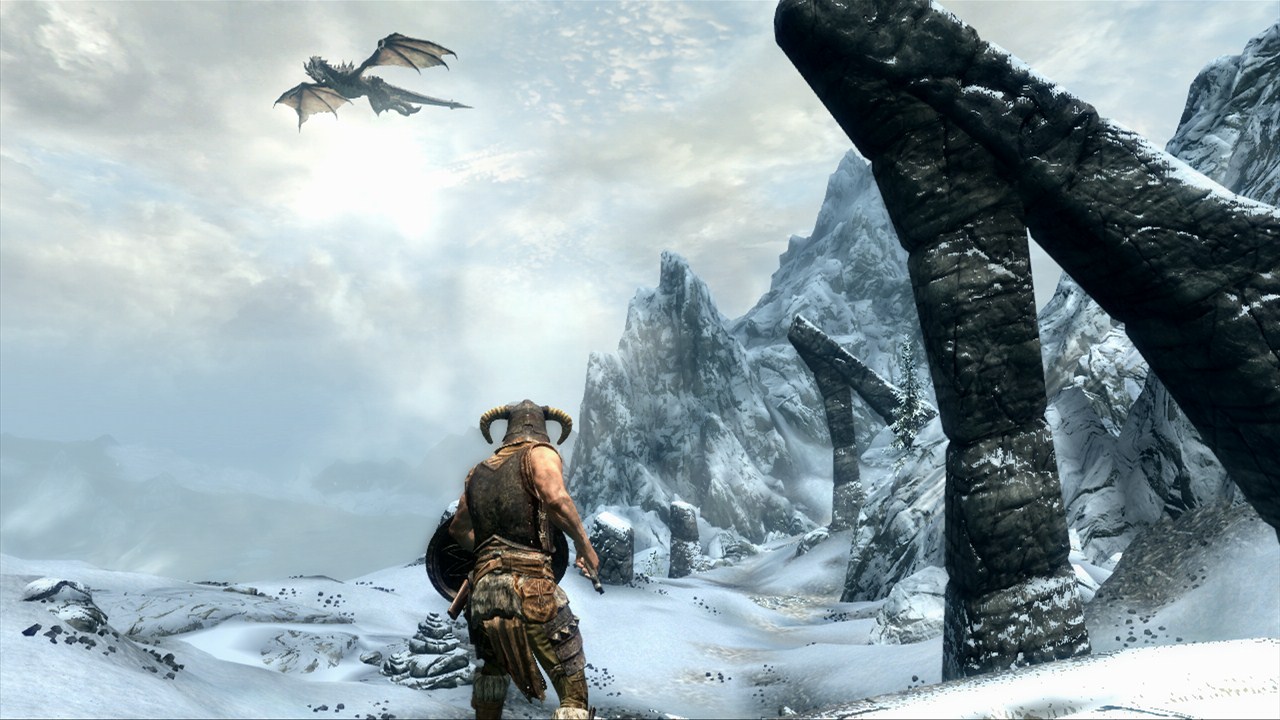
As the Dovahkiin you have access to one other ability: shouts. As you progress through Skyrim and explore both the story as well as the many, many locations scattered throughout the province you will locate pieces of the dragons’ language. Each location will yield one word of a phrase that you can wield as you see fit and each word is unlocked by absorbing a dragon’s soul. Each has a different effect when used and as such differing degrees of recharge times (you cannot spam them endlessly). Earning souls and learning words to fill a full phrase can unlock powerful variants that cannot be overstated in their usefulness. These improvements are definitely superior to their lesser counterparts, the difference being using a shout to cause an enemy to flinch and fully knocking them off their feet and throwing a fireball and unleashing an inferno. Shouts are exceptionally useful in combat and can often mean the difference between life and death.
Earning dragon souls is no easy task and it is here that we address the most talked about (and anticipated) part of the overall Skyrim experience: fighting dragons. You will find that, while some moments are scripted to continue the story along, a vast majority of the encounters with dragons are either random occurrences or even optional endeavors. You will often find yourself wandering through the land only to hear a sharp rush of air and the roar of one of the beasts as it passes overhead. However, despite its imposing arrival they will sometimes just circle overhead and fly off. The random nature of the dragons really makes the experience more exciting.
Fighting a dragon is no small order of action though. Should you engage (or perhaps be engaged) by a dragon you’ll find yourself fighting a formidable foe that, at a bare minimum, is as strong as you are. These beasts will fly around and attack you from every angle, often forcing you to shift between short range attacks and long range ones with a bow and arrows. Dragons also come in a variety of types such as fire, frost, blood and more so you may have to shift your strategy based on exactly which one you are fighting. Dragon attacks can sometimes have you facing two of them at once as that very scenario happened to me. Should this become reality your only hope is to use the terrain to your advantage and pray you are near a settlement whose defenders will come to your aid but if neither of those can be utilized it is probably in your best interest to act on the later part of your fight-or-flight instinct. Regardless, fighting a dragon never gets old and when the sweeping chorus of Nordic chanters take over the game’s soundtrack and the beast begins flying toward you murderously you’ll always draw your sword with a smile on your face.
The (Other) War in the North
For each of its titles from 2002 to 2008 Bethesda Softworks utilized an engine called Gamebryo. This engine, while remarkable last generation, looked muddled in Oblivion and was universally decried in Fallout 3. Thankfully Bethesda uses a new engine in Skyrim called Creation and while the results yield similarities to what we’ve played before this new one is quite the generational leap. Draw distance and environmental depth are the key focuses of Creation and it is immediately noticeable upon stepping foot in Skyrim for the first time. The game smartly has little to no invisible walls (a large problem in Fallout New Vegas) and The Throat of the World, the tallest peak in all of Tamriel, is climbable, something that many are going to want to do from the moment they begin the game.
Beyond height and draw distance you will find that Creation allows for a deep and quite lively world to explore, more so than anything Bethesda has ever created. Forests are large and alive with animals living their lives underneath the canopies of tall trees. No one location in all of Skyrim feels generated for the expressed purpose of existing and the world actually feels quite alive. These changes aren’t limited to the world however: the citizens of Skyrim are just as vibrant in their lives as the outside world is. Character models no longer seem randomly generated and the compliment of voice actors this time around doesn’t seem nearly as small in number. Conversations no longer zoom in on the (previously ugly) faces of people and the world continues on outside of your interactions. The world of Skyrim is incredibly engaging and one you will love exploring.
One specific note that audiophiles and regular gamers alike should know about is the sound design. Simply put, Skyrim absolutely has to be experienced in 5.1 surround sound and it is almost a waste to do otherwise. The sound design is already fantastic but it is worth noting that, at least in the Xbox 360 version of the game, there can be some localized sound issues to be had with playing with a 2.1 or lower sound system. In this scenario, at least during the pre-patch timeframe, sound often cuts out drastically when moving the camera away from active sounds and the simulation of sound coming from the side and behind you is dramatically different, yielding a product that makes a lot of interaction with the world a bit annoying. Again, this is something that can probably be fixed through a post-release patch or even a properly calibrated sound system but for those who do not have a surround sound system you’ll immediately want to upgrade as soon as you experience Skyrim with one.
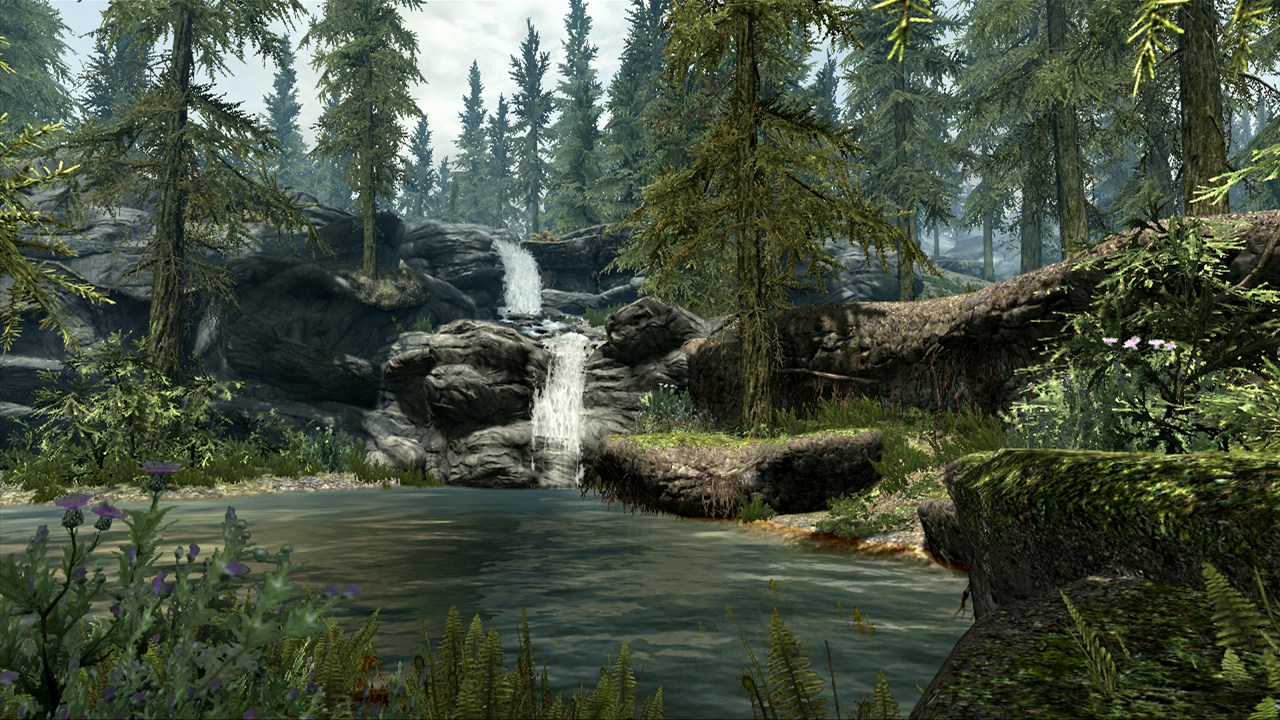
The Champion of the Fourth Era
When I sat down to review Skyrim I was quite apprehensive. After all, I really didn’t enjoy Oblivion much outside of the first few hours and while I was actively engaged in Fallout 3 I did not like the idea of returning to melee-only combat. What I’ve come away with however after over forty hours of gameplay already is a title that I was completely wrong about. Skyrim is a game that not only will draw in Elder Scrolls fans but also new gamers alike with a gameplay design that you’ll be hard-pressed to put down the controller whether it is 2pm or 2am. Combat in the game is engaging and the amount of things to do and places to explore is staggering even for an Elder Scrolls title. After a week of playing the game for hours on end I still want to dive back in and fight another dragon, liberate another town and learn more shouts.
Simply put, Skyrim isn’t just the best title Bethesda has ever made: it is probably one of the top releases of this generation. Mage or thief, Nord or Khajiit, PC or console, the results are the same: you will love Skyrim.
Review: Ace Combat Assault Horizon
 Thursday, October 20, 2011 at 5:36PM
Thursday, October 20, 2011 at 5:36PM 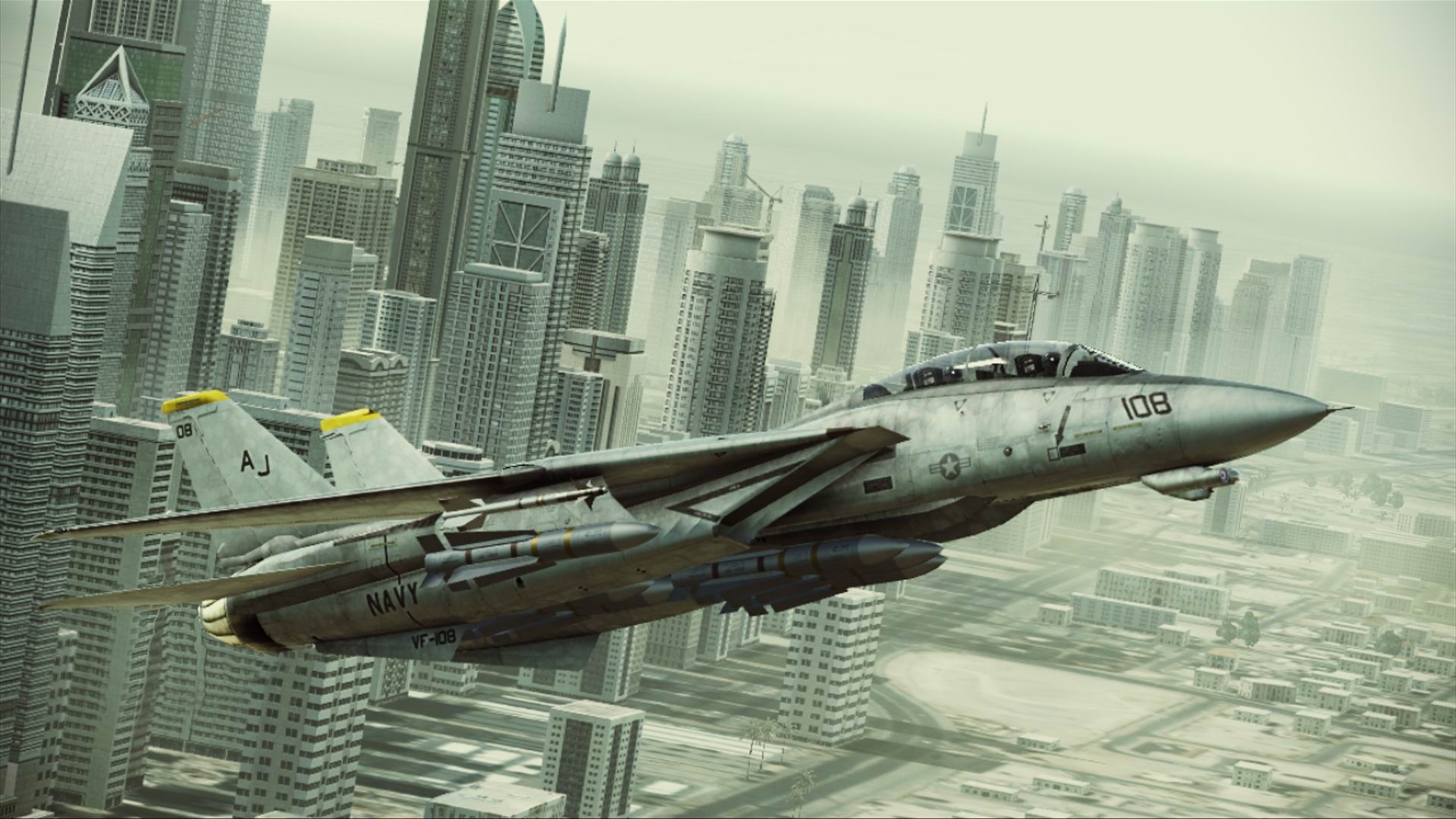
I’ve been writing about video games for years but it wasn’t until 2007 that I really got into it. My first test of what I could accomplish as a writer was Ace Combat 6: Fires of Liberation. At the time I lamented the downfall of the flight sim genre on the home console scene and while it’s been four years since the last time I flew into combat the gaming space has yet to make up for this upsettingly barren landscape. Although there have been valiant attempts to breathe new life into the genre with a pair of Tom Clancy titles and an upcoming revival of the Janes Combat Simulations brand the genre has been relegated to either the standard World War II sim or the occasional realistic civilian aircraft title.
Four years is a long time to go for most game series but Ace Combat is thankfully back, albeit quite different from what we left it as. With a modern makeover fans can expect to see more new than old but is it enough to draw newcomers to the series?
Click to read the full article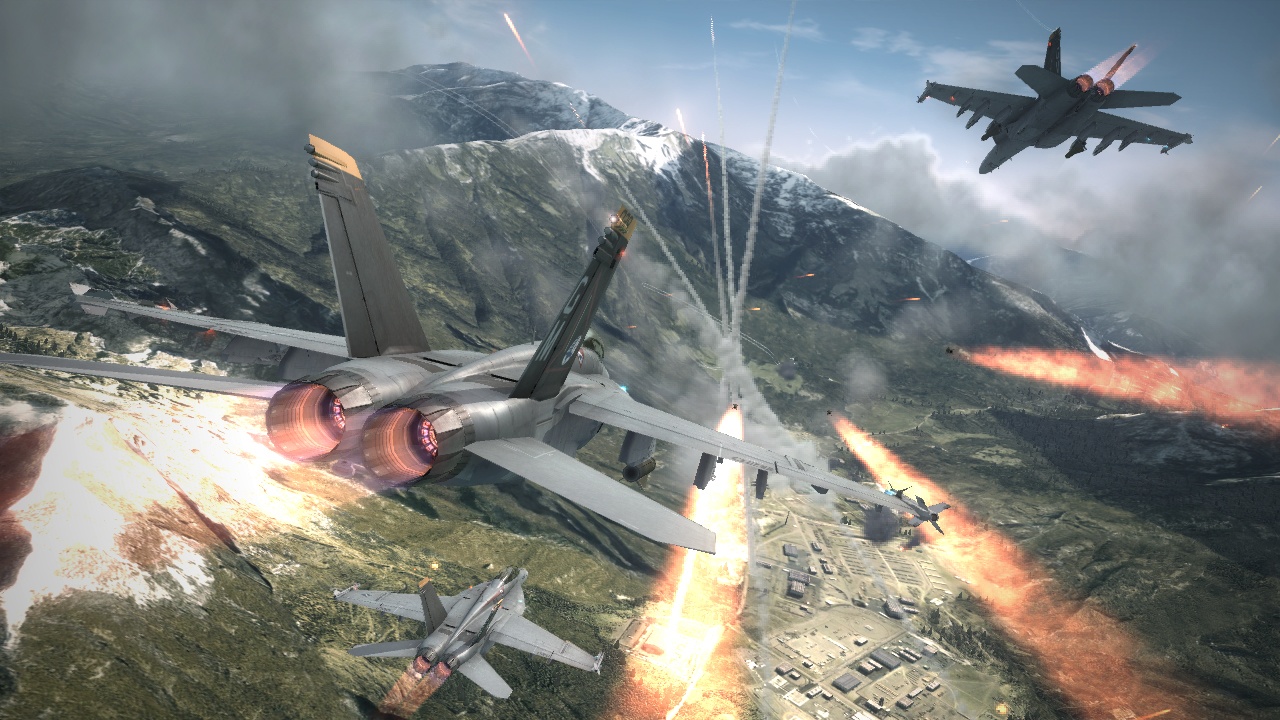
The Wild Blue Yonder
The Ace Combat series has always been a fantastical one, trading our gigantic selection of modern weapons and vehicles for a world that is vastly different and yet familiar. For all the core titles released from the beginning of the series up until 2007’s sequel each one took place in what Project Aces, the series’ developer, called the “Strangereal,” an Earth that reflected our own while focusing on separate yet constant wars between various nations. Ace Combat 2, 3 and 4 told of conflicts on the continent of Usea while 5 and Zero detailed the Osea/Yuktobanian conflict and the events that lead to it fifteen years prior during the Belkan War. Ace Combat 6 was comprised of a small localized war between a pair of countries north of Yuktobania but given its isolated nature it didn’t really draw in the player nearly as much as 5 and Zero did.
Twenty years of war is quite a lot to take in and given that almost every country in Strangereal has taken part in one conflict or another it shouldn’t come as a surprise that Namco would want to give the series a bit of a refresher. Given the fictional state of the nations, weapons and so much more in the previous entries in the series one would expect a more sci-fi oriented effort like that seen in Ace Combat 3. Namco had other plans however as Assault Horizon takes place in our modern day world and, wouldn’t you know it, it sticks to modern settings as well.
Taking place in 2015, the story written by New York Times bestseller Jim DeFelice details the exploits of a NATO-organized unit called the 108th Task Force assigned initially to counter an insurgency that is sweeping throughout the African continent. Playing as one of four characters (the role of Lt. Col. William Bishop being your primary character) you’ll swap out between characters to tell various perspectives in the overall conflict that takes you all over the world. The cast does seem to have more character in them than in previous entries but for the nostalgic Ace Combat veteran like myself you’ll probably be drawn more to Ace Combat 5 and Zero’s cast and plot.
Let’s just get this out in the open: yes, just like you’ve probably guessed, the game involves evil Russians attempting to destroy the US just like in pretty much every modern war game released this generation. The entirety of the conflict revolves around a Russian-developed superweapon called Trinity that’s just south of a nuclear weapon without the after-the-fact problems of fallout and the like that come from them. Why this weapon is necessary to the plot is anyone’s guess since nuclear weapons make a lot more sense in a plot like this than an unstable, thermobaric one like Trinity but I guess DeFelice had to have some kind of sci-fi plot device so here you go.
For a game written by a NYT bestseller it is a wonder why DeFelice has crafted such a heavy-handed, generally unexciting story. Assault Horizon’s plot has all the shock and awe of a straight-to-paperback, single edition novel and the game’s characters really lack almost any depth save for a bit of introspective fear on the part of Bishop. The game’s training level, a nightmare sequence that makes Bishop wake up sweating from, comes back to haunt him later in the game and while this stage could have dealt with some psychological elements (it would have been cool to see a Dead Space-esque freak-out sequence during this) nothing is explored. Perhaps this can be attributed to the outsourcing of your storyline to another writer but I like to assign that blame to the application of a modern setting in our world.
I’ll put it straight: don’t come to Assault Horizon for the story. If you want an example of a fun, driven narrative then go find yourself a used copy of Ace Combat 5 and play that.
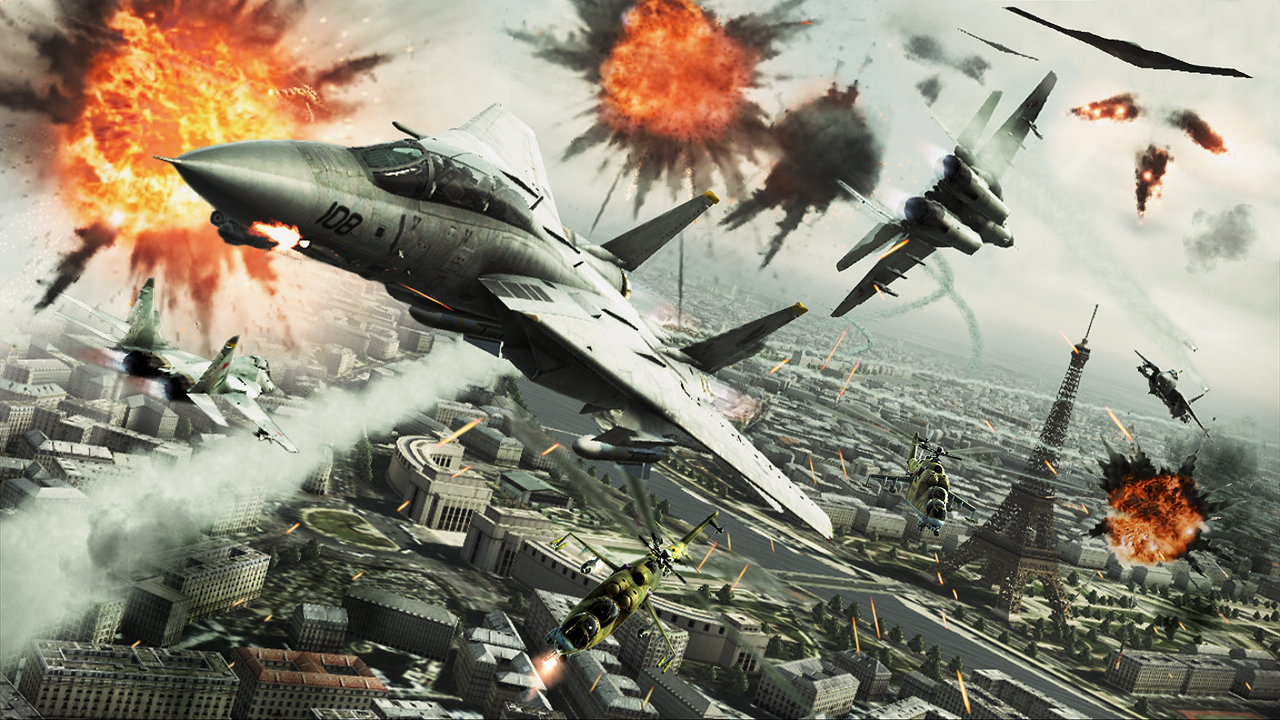
Too Close for Missiles
Four years is quite a bit of time for which innovative gameplay advances can be added and historically the Ace Combat franchise has taken advantage of every development time to introduce new, intriguing gameplay elements that complement the overall experience quite well. Ace Combat 5 had a wingman command system; Zero had a dynamically shifting story based on your actions and 6 allowed you to command allied units in combat. Assault Horizon has had plenty of time in development and it is safe to say that Project Aces has taken advantage of this long timeframe to add plenty to the game. What the veteran Ace Combat player will find remarkable however is just how unique a game it actually is in comparison to all the previous entries.
The biggest and perhaps the most drastic new element is Dog Fight Mode otherwise called DFM. Throughout the game you’ll come across a variety of tough opponents that cannot be taken down in the traditional manner of “get behind, lock and fire a missile.” Instead what you usually have to do is get close in behind them and engage Dog Fight Mode which causes the game to enter a semi-scripted sequence where you chase your opponent as they do almost everything they can to shake you off. During these sequences the enemy will turn wildly and fly low amongst the terrain through and around whatever they can. For the most part DFM can be quite entertaining but the problem lies in the game’s over-reliance on this mechanic. Traditional combat is quite a bit harder in Assault Horizon and many of the game’s enemy’s demand DFM in order to get a kill. These fast-paced moments do draw you toward the detail in the world and make you feel like you’re actually chasing an enemy fighter through the skies but once you’ve flown by the same exploding skyscraper for the eighth time it starts to drain on you.
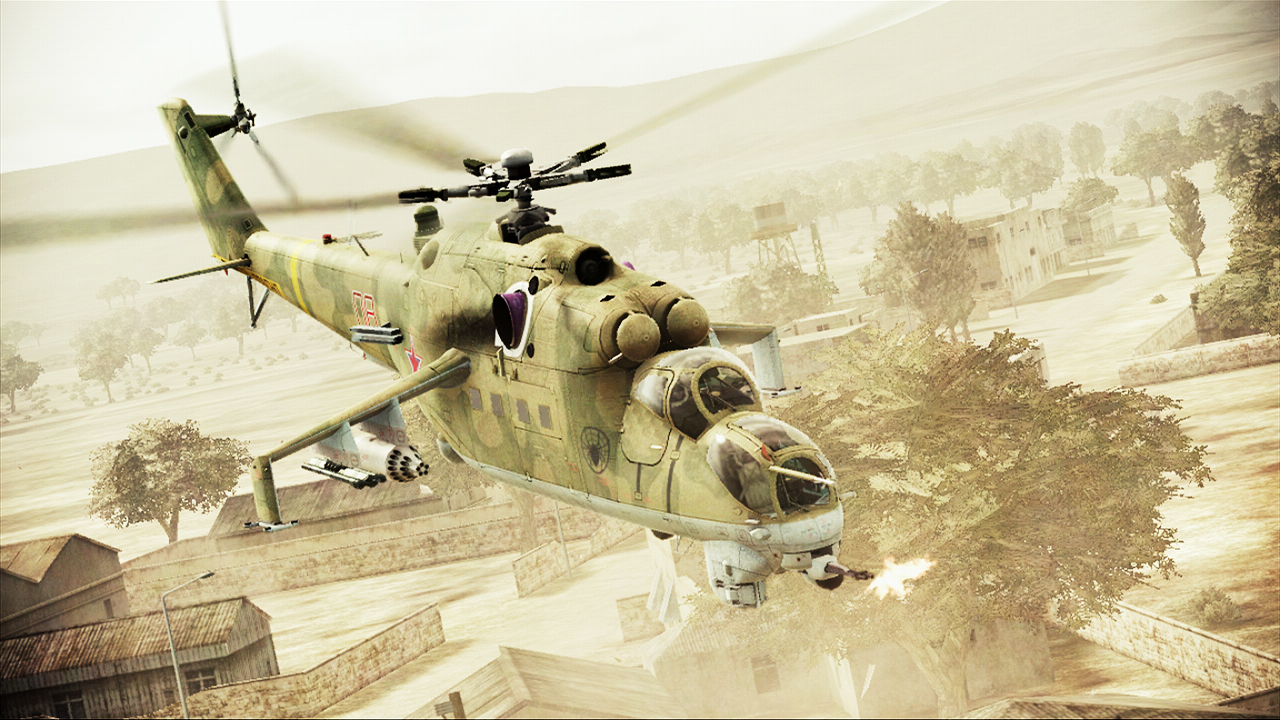
Along with DFM comes the Air Strike Mode (ASM) which functions similarly to DFM. In combat you’ll be shown entry points to engage in an air strike that has you flying within a corridor area filled to the brim with enemies. Your weapons during an air strike reload and lock on much faster than they normally would but you cannot reenter them in the event of a navigation error or not killing all the enemies on your pass. It actually plays out better than a dog fight as they are less frequent and actually make sense at times during the campaign (the amount of destruction you can dole out in seconds doesn’t hurt either).
Other than DFM the largest change in Assault Horizon is the amount of the game that doesn’t have you zipping through the skies in a fighter jet. Separating fighter missions from one another you’ll find an assortment of helicopter and bomber-based missions to be had. The helicopter sequences, one putting you in the seat of a Blackhawk’s door turret and the other in control of an Apache Longbow, bring you close to the ground and give a sense of greater conflict that can only be surmised when flying at Mach 2 20,000ft in the air. Only two bomber missions are included in the game with one recreating the infamous Death From Above level from Call of Duty 4 in an AC-130 while the other challenges you to pilot an enormous bomber under a radar net before wiping out hundreds of enemies. The variety to be had is a welcome distraction from the DFM-heavy moments when flying a fighter but each one could have played through a bit better.
Perhaps the biggest detraction from the overall experience is the last of mystique and fantasy. As the game takes place in a modern setting you won’t find anything that really wows you and gives Assault Horzion a grand sense of scale. Gone are the amazing flying wings that launch protective fighters, the stunningly huge fortresses and the cool superweapons that you have to fly INTO in order to destroy them. You won’t be dogfighting against fictional planes nor will you be racing to the deck to get under a 500ft altitude limit as enemy aerial weapons wipe out anything in the air above you. With the sci-fi element gone from the game you’ll get the feeling that this really isn’t a proper Ace Combat title. Perhaps we’ll see a return to its roots someday but for now you’ll have to be content with shooting down cruise missiles and Russian bombers that take eight missiles to down.
Tally on the Bandit
Assault Horizon may falter in the gameplay department but it is clear that they know how to deliver with the game’s presentation. The latest title in the series benefits from a revamped engine and it clearly shows at times as the planes are wonderfully detailed and the cityscapes look simply gorgeous, albeit at a distance. Textures up close can look a bit muddled up close (especially so when flying through outlying areas of a map) but given the fact that this is always a problem with all flight sims and that you should be more concerned with the fighter chasing you it is quite forgivable.
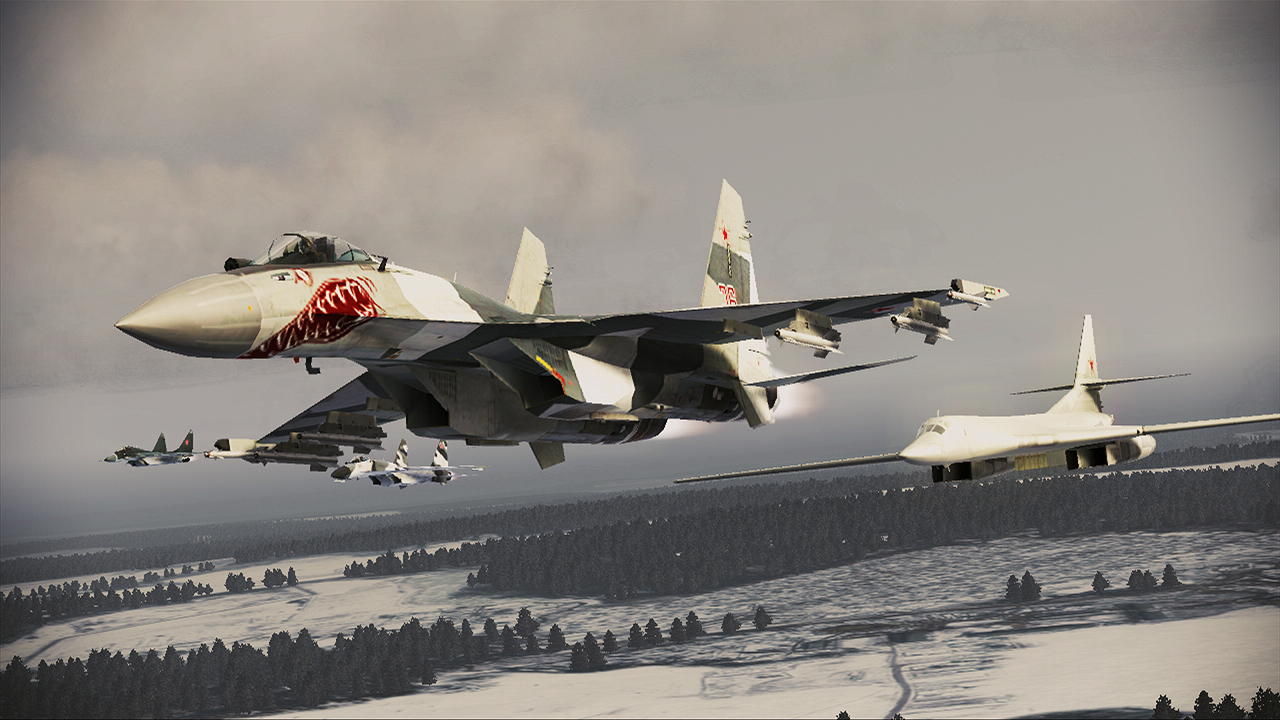
The audio part of the game’s presentation is by far the best part of the game. The Ace Combat series has always been known for a sweeping, exciting rock/symphonic medley that’s complimented by an occasional orchestrated piece with a sand script choir but Assault Horizon is probably the best one to date. Horizon takes the rock elements seen in the PS1 entries in the series and brings them back in a big way, driving you forward and squealing in glee as you soar through the skies after your next target. It feels and sounds epic and you can’t help but love it.
One final note of appreciation I have for Assault Horizon is just how proud it is of its legacy. The Strangereal games may be a thing of the past but Project Aces isn’t about to let those characters fade into memory as, amongst the game’s large amount of unlockables you can get various skins for each plane. These were present in Ace Combat 6 in the form of some ludicrously overpriced DLC but now you can wear the colors and skins of the Scarface, Mobius, Razgriz, Yellow squadrons and more by completing in-game requirements. Furthermore veterans will be pleased to hear that an new fantasy plane will be coming to the game soon designed by none other than the legendary Shouji Kawamori, the man responsible for a little anime series you may have heard of called Macross. Futher DLC down the line promises new locales and more to extend the game’s experience but just being able to dawn the colors of a Demon of Razgriz is enough to get me excited.
Splash One
The Ace Combat series has always been one that has had one primary, overall goal: put you behind the stick of a fighter jet and wipe the floor with anything that gets in your way. For the most part the series has succeeded in this regard but with Assault Horizon it simply doesn’t really feel like the game series many have loved over the past fifteen years. It is clear that Namco and Project Aces want to remain competitive in a market that is dominated by only a handful of titles every year and they are making good strides in this direction by drawing the player into combat closer than the series has ever been before. The thing is though that it just hasn’t done a well enough job.
Finding the balance between traditional Ace Combat gameplay and modern war title aesthetics is going to be a heck of a job for Project Aces to try and accomplish going forward but give that this is the first game in the series out of eight titles that didn’t have me coming back through for a fifth playthrough I’ll forgive them. Better luck next time guys.
Review: Rage
 Tuesday, October 4, 2011 at 10:33AM
Tuesday, October 4, 2011 at 10:33AM 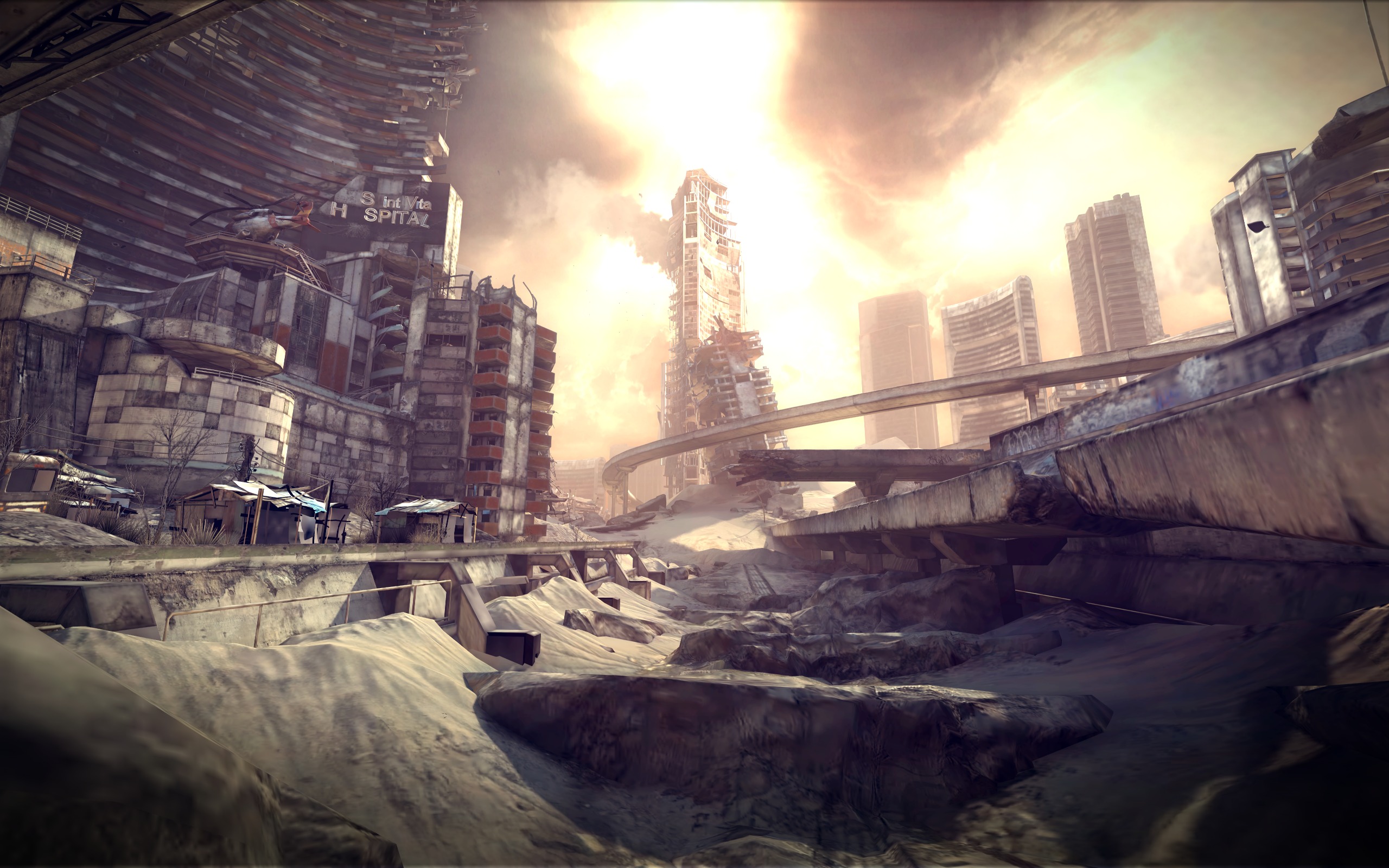
When I was six years old I remember sitting on my dad’s lap at his 486 computer watching him play Wolfenstein 3D. For me, id Software has always been a unique studio that doesn’t so much adapt to the times as it forges its own interpretation of what they feel a good game is. Say the names Wolfenstein, Doom or Quake in a crowded room of gamers and you’ll have a hard time finding someone that hasn’t played or at the very least knows about these amazing franchises. After Doom 3 was released in 2004 id all but disappeared from the development scene, really only appearing at their annual QuakeCon convention in Dallas, TX while letting developer Raven Software continue the Quake and Wolfenstein franchises. Raven’s continuations didn’t capture the magic id Software can bring to a game however and as such desperate fans like myself were left waiting in the wind.
Rage, id’s first new IP since they introduced Quake in 1996, is something of an event for me. In addition to being the first time anyone will have been able to play a core id Software game in seven years it is also my first opportunity to review an id title since I started writing about games. After seven years though one must ask: is the magic still there?
Click to read the full article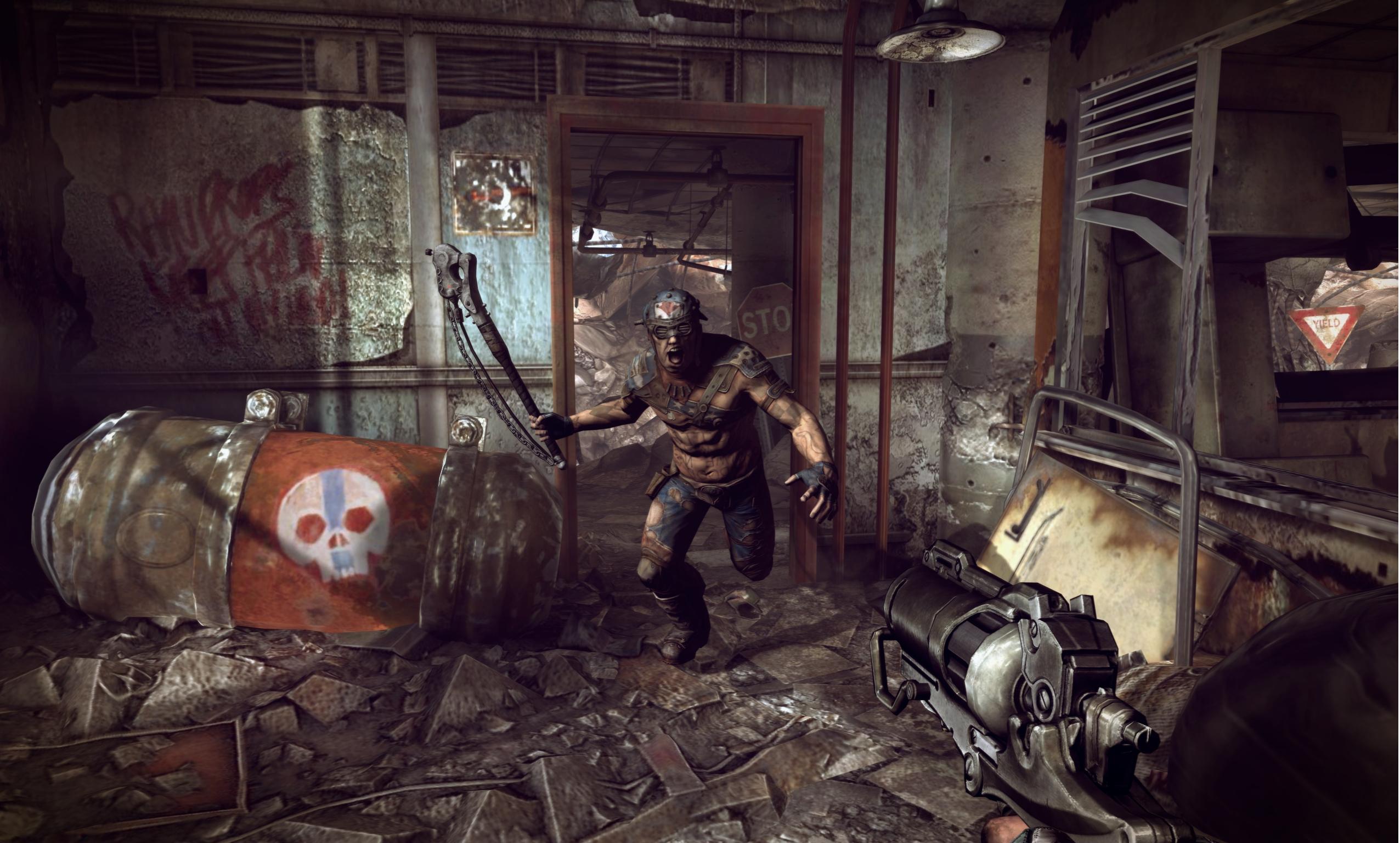
Welcome to the Wasteland
Many have the justified fear that the end of the world will come from above in the form of an asteroid that will bathe our planet in fire. 99942 Apophis, an asteroid that’s 270m in diameter will pass by Earth in 2029 and 2036 and presents as a level 1 threat on the Torino impact hazard scale. In the world of Rage however the threat is far greater as it is the size of Manhattan. Five years prior to its 2029 impact date the international community rallies together for the Eden Project, a program designed to ensure the survival of our species beyond the collision. Arks, underground containers designed to house the best and brightest amongst us, are constructed all over the world and while thousands are built it isn’t enough. As the asteroid hurtles past the moon the Ark program initiates and you, the player, are sent into cold sleep.
You awaken with a start to a ghastly sight. Over a hundred years have passed and everyone but you who were placed in your Ark is dead. Stumbling outside, you are besieged by a group of bandits only to be saved at the last minute by Dan Hagar, a man who lives nearby and has gotten along by staying out of trouble. Saving your life has changed this though and as you drive off with him toward his settlement one thing is clear: the rules of the old world are gone and you must do more than live to get along. You must survive.
Rage’s post-apocalyptic story is about your journey to find your place in the Wasteland. Ark survivors are a rare order to find and as one you have the skills and know-how to make the Wasteland a safer place. The ultimate threat to the safety of the remaining human population isn’t the clans of bandits or the mutant hordes that have arisen since the fall of Apophis. Rather, the prime threat is actually the Authority, an advanced military body that thrives on pre-impact technologies and since you happen to be an Ark survivor they want you bad.
The Rage singleplayer experience is one that will draw many comparisons to another post-apocalyptic game series: Fallout. While the two share many traits in both story and gameplay Rage is an entirely different affair as it is a directed narrative instead of a non-linear one like Bethesda’s juggernaut title from 2008. Rage does allow you to explore the Wasteland as long as you see fit but only by completing quests does the plot advance and allow you into sections of the map you couldn’t access before. While some may lament the lack of being able to go anywhere and do anything id is able to deliver a stronger story than can be told through a game like Fallout. Fans of Bethesda’s wonder-series should be pleasantly surprised by id’s offering.
Rage’s campaign, despite being a directed experience, is still quite long, offering in excess of twenty hours of gameplay in a single playthrough. While the overall experience in the singleplayer is quite entertaining you’ll find that the ending is a disappointing affair that feels like it was cut halfway through development. Perhaps this is a sign that id has decided to capitalize on the success of the post-release DLC that made Fallout 3 and Fallout New Vegas so successful but, as it stands, you’ll be left wanting more.
The Art of 22nd Century Combat
When I graduated from high school one of the things I did with my graduation money was build my first computer. This seemingly daunting yet easy task was done in excitement for two of the biggest PC games of the year: Half-Life 2 and Doom 3. While I loved Gordan Freeman’s unique journey I found myself enjoying Doom 3 more as it was both a wonderfully scary experience while having some fantastic gameplay. It was the first major release for id since Quake 3 Arena and the first singleplayer-oriented experience in seven years. It was dramatically different from everything id had done before and this change in design felt, well, fantastic.
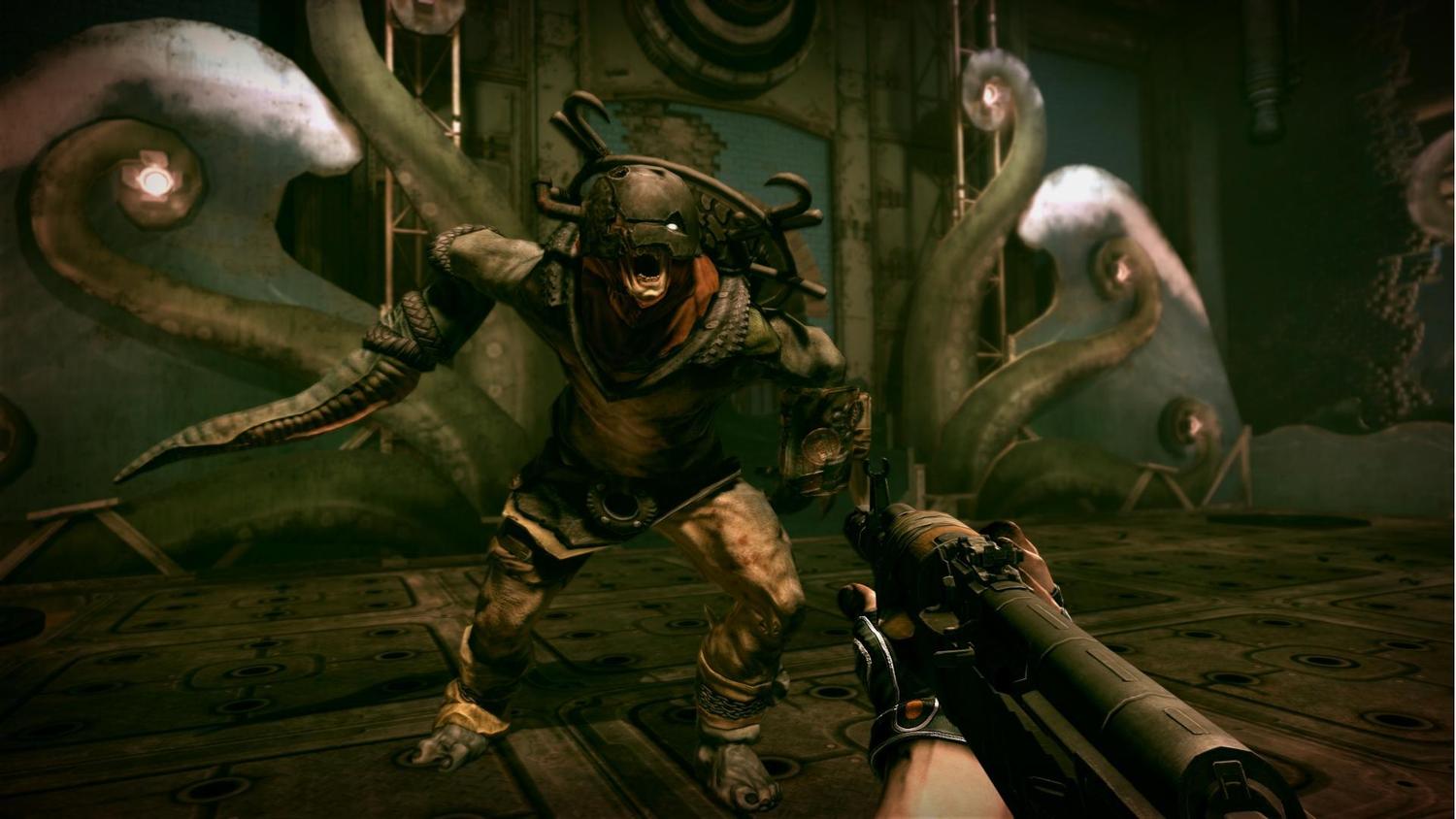
I bring this up because, in many ways, Rage reminds me of Doom 3. At its core it is still that wonderful corridor-fest shooter that left me with unfortunate stains in my underwear and while the scary element isn’t nearly as present in Rage (though there are moments that will make you jump) it still plays much like it did back in 2004. You will find far more larger portions of a level than the decidedly claustrophobic buildings of Doom 3 but in the end it is still what it was seven years ago which isn’t a bad thing at all.
What I really enjoy about an id title is just how unique it feels compared to the rest of the shooter genre. The characters, weapons, tools and levels you explore seem familiar and yet have a unique spin on them that identifies them as an id Software creation. For example, it is a common practice in games with creatures like zombies and mutants to have them charge at you but in Rage they’ll climb the walls and ceilings, leap form great distances without warning and even accurately throw their weapons at you, negating an attempt to circle-strafe. It is really hard to describe in print what id Software brings to a gameplay experience but once you’ve cut your teeth on Rage or Doom 3 you know what I’m talking about.
Weapons in Rage run the usual gauntlet you’d expect in a shooter as you start with a pistol, graduate to a shotgun, and eventually get rifles, machine guns, rocket launchers and the obligatory alternate weapon in the form of a crossbow. What makes them different however is that they allow for different types of ammunition that can be utilized and changed on the fly, much like what Irrational Games and 2K Marin have done with the Bioshock series. Feel that a well-armored enemy is too tough? Switch out your buckshot for some Pop Rocket rounds that will make short work of them. Too many enemies? Thin them out by using the Dynamite Bolts for your crossbow. The mix of different ammo types allows you to give more personality to your play style and definitely compensates for the game’s compliment of only seven primary weapons.
What truly adds to the gunplay though is the ability to deploy quick use items that aid you in battle. Using a relatively simple crafting system you can build a wide assortment of items such as specialty grenades, bandages and even sentry turrets and bots to aid you in case the combat gets too much for you. The sentry turret by far is extremely entertaining in that it, both in design and functionality, operates exactly like the spider bot from Doom 3. Having an extra gun firing at the enemy is always handy but when this robot has the ability to move around, do melee attacks and comes back to you when the firefight is over, looking at you like a happy puppy ready for you to throw the ball again, you can’t help but fall in love with your little spider friend.
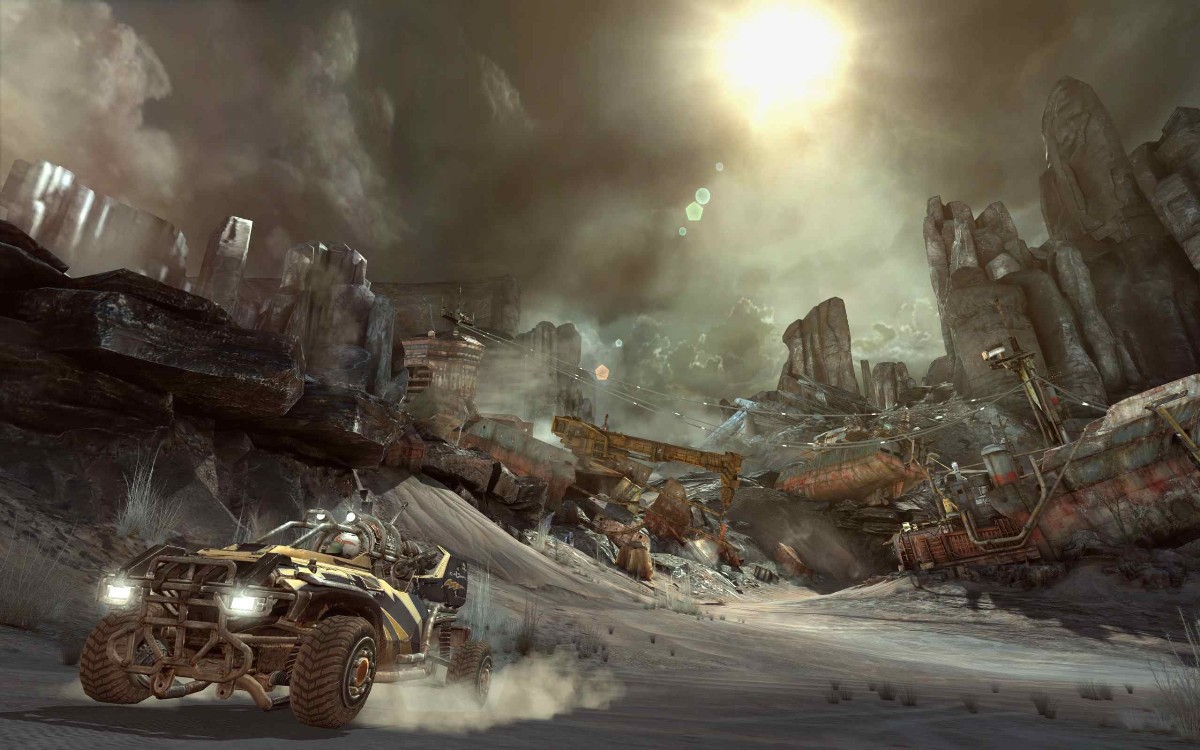
Death Race Anyone?
There is one more significant portion of the game that must be addressed: the addition of vehicles. Vehicles have never been featured in an id Software title in a functional capacity and so their inclusion in the game’s initial marketing overshadowed the gameplay on display, an act that still has many confused. I can safely report that, while you will spend a lot of time in a car, the use of vehicles in the game only amounts to roughly a third of the overall gameplay experience. You will be using one of four different vehicles to travel about in the Wasteland and each has a different feel to them but not in a way that will make you prefer one over the other. Handling across the board is quite arcade oriented and only during combat do they take damage so you don’t have to worry about running into walls all the time and banging up your ride.
Vehicular combat in Rage is a surprisingly fun affair as you have a variety of weapons and quick use items available at your disposal. These combat sequences appear at random throughout the game and are encouraged by NPCs in the various hub towns you find. Ramming, gunning and chasing are the order of the day when fighting off attacking bandits and fortunately it never really gets old. The end result is a deliciously Mad Max-esque experience that really doesn’t drag down the overall gameplay at all.
Outside of combat you can also compete in races. Time trials, standard races and rally events are what you’ll be competing in and, with the exception of some rally events, you’ll find them quite enjoyable. The races can be of both the unarmed and armed varieties and the rally events, which are similar to flag collection events (think Rocket Race from Halo 3), are completely weapon focused. You will die in your races, rest assured, but you respawn almost instantaneously in a manner similar to what is utilized in the MotorStorm series.
The inclusion of vehicles in Rage is something that still puzzled me until I got my hands on it but if id can keep the formula as simple as it is now and retain the fun factor it already has I’ll gladly play a racing game with their name on it.
You Aren’t Alone Out There
Id Software has a varied history when it comes to multiplayer. While the Quake series has seen massive success on this front its other series never really hit the ball out of the park. Doom 3’s multiplayer seemed like an afterthought done boring but with the way most shooters are going these days you are all but obligated to include a multiplayer component in your AAA title. Rage is no exception to this rule and it is here where you’ll find that id hasn’t been rather successful.
Variety is something that’s easily acquired in Rage’s multiplayer as you have almost every flavor under the sun available to you in the form of cooperative play as well as competitive car combat. The co-op, entitled Legends of the Wasteland, places you and your partner in the roles of NPC characters from the singleplayer campaign in missions that take place canonically before the singleplayer begins. Each of the nine missions detail a story or event hinted at during the game and are unlocked progressively meaning you’ll have to play them in order to experience them all. The end result is what you’d expect: fun, but clearly needing more to flesh it out. Experienced Rage players will enjoy themselves but those looking for more will find themselves not coming back after completing them.
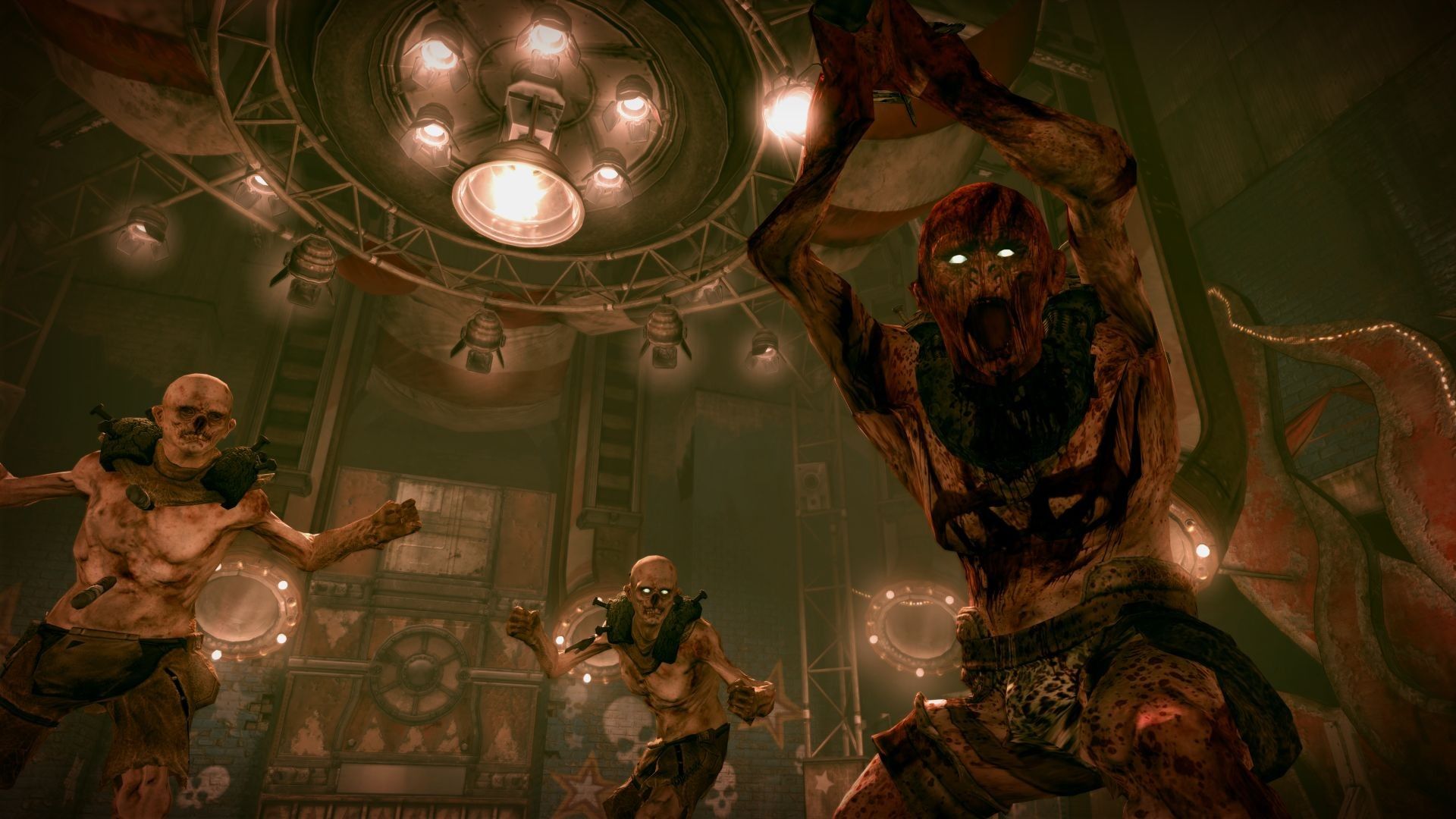
The competitive part of the multiplayer is Road Rage, a four player affair spread across three rally modes and a classic vehicular combat mode called Carnage. The meat of the experience is Carnage wherein you battle one another to get the highest score before the time or score limit is reached in a decidedly id Software take on classic Twisted Metal. Rally events are fun but won’t keep you excited for long as they all feel the same and with only a very limited level of customization for your ride and a handful of maps you probably won’t be playing it past a week or two.
The thing about the multiplayer is that it has so much potential that it is squandered by just how little there is to do. Traditional deathmatch play screams for inclusion and yet it is frustratingly absent. Races too would have been quite fun and probably would have felt like a post-apocalyptic Mario Kart had they been included. As it stands however it is quite a wasted opportunity.
The Attractiveness of Desolation
Seven years is a long time to go without releasing a new game but id found justification in the creation of their new game engine. Called Id Tech 5, this behemoth of an engine has Rage as its flagship title. While the full capabilities of the engine are never explored in its initial outing (developers are still pushing the Unreal 3 engine) it is clear that Id Tech 5 can do amazing things.
Texture detail, especially in the Wasteland’s rock formations, can be incredibly impressive at times and really make you wonder whether what you are looking at is an artist’s creation or a photo taken at Monument Valley. Animations for NPCs and enemies are wonderfully well done with very well hidden transitional animations and movement patterns that make you sit back and go “wow.” As you blast into a charging mutant and watch as they elegantly leap off a wall toward you only to be at the wrong end of some buckshot you will find yourself agreeing with me that this is only of the most beautifully animated titles since Uncharted.
What really sells Id Tech 5 however is Rage’s fantastically smooth framerate. Id was able to deliver a sold 60fps on the home consoles, something that is an increasing rarity in games these days if your name doesn’t include the word “Duty.” Blazing along the trails of the Wasteland and hitting a bandit car head-on yields absolutely no drop in framerate and, despite my best efforts, I could not find a single instance of lag. Id has done a masterful job on their new engine and I can only hope that it gets the attention from the development community it much deserves.
One final note I must mention is that I love id’s style in Rage. Every developer utilizes old assets in their games but id Software has the habit of reinterpreting them for the world they are making next. Within Rage you’ll find a remarkable number of textures and geometry (a style I would call Techno-Gothic) that comes directly from Doom 3. Dan Hagar has a Doom marine bobblehead on the dash of his buggy and one character you meet later in the game even has the Martian drawing of the Cyberdemon tattooed on his head! Id is clearly aware of its heritage and, while forging onward with their technology they have still found a way to make the old still relevant.
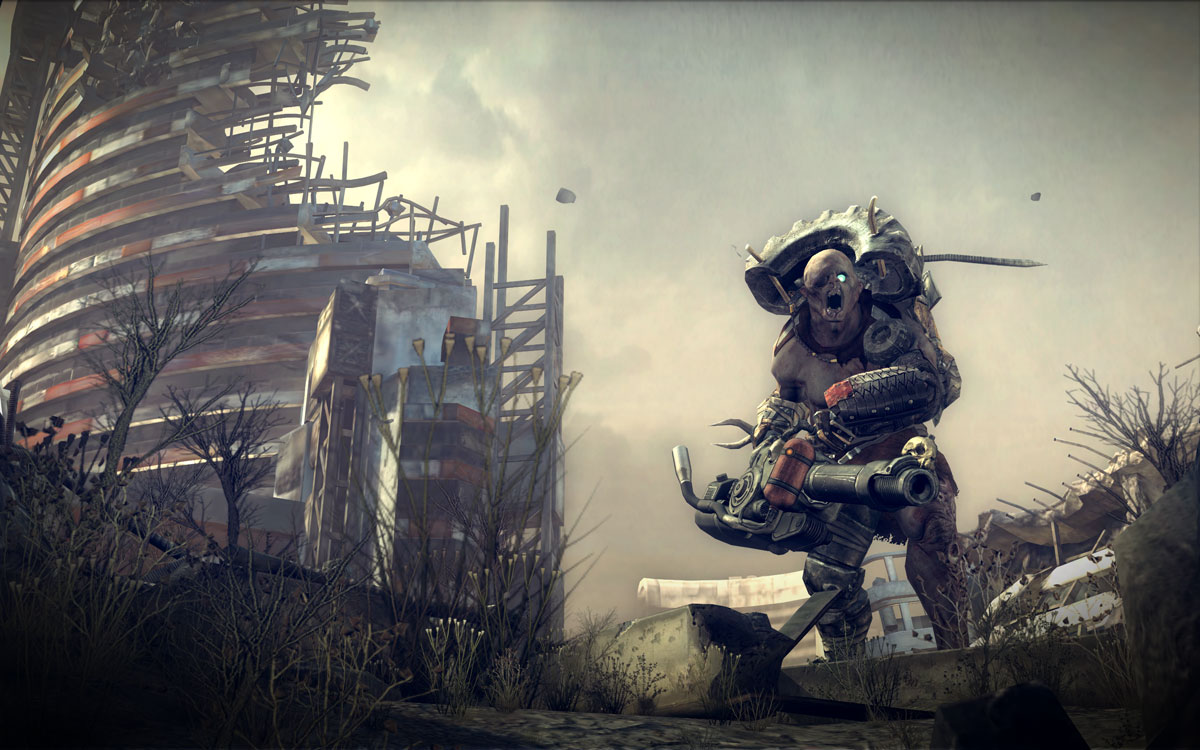
Contain Your Rage
When you sit down to name a game its designation has to be something that resonates with the core theme of the game. Wolfenstein told you that you were going up against the Third Reich. Doom told you that you were about to face the minions of Hell and probably wouldn’t survive. Quake, in so far as the original title goes, placed you in the role of a god-like character who made enemies tremble before you. With Rage however it seems that naming your game after a raw emotional state just doesn’t quite translate to the overall experience. The game’s great singleplayer experience feels excellent until it drops off abhorrently at the end in a manner that is sequel-mongering at its finest and the multiplayer seems almost tacked on at times.
Rage is a solid experience but it shames me to say that the game isn’t as true to id Software’s legacy. While the development of a new engine is an almost adequate excuse for the game’s shortcomings it doesn’t make up for them. You’ll enjoy Rage for what it delivers on the singleplayer front but for those looking fun with friends should hold off to see what the game’s DLC is like. Maybe one day I’ll get to have a son who sits in my lap and helps me play Rage 3 but unless id Software really delivers with Doom 4 I fear that the magic may be beginning to fade.
Review: Gears of War 3
 Wednesday, September 28, 2011 at 2:17PM
Wednesday, September 28, 2011 at 2:17PM 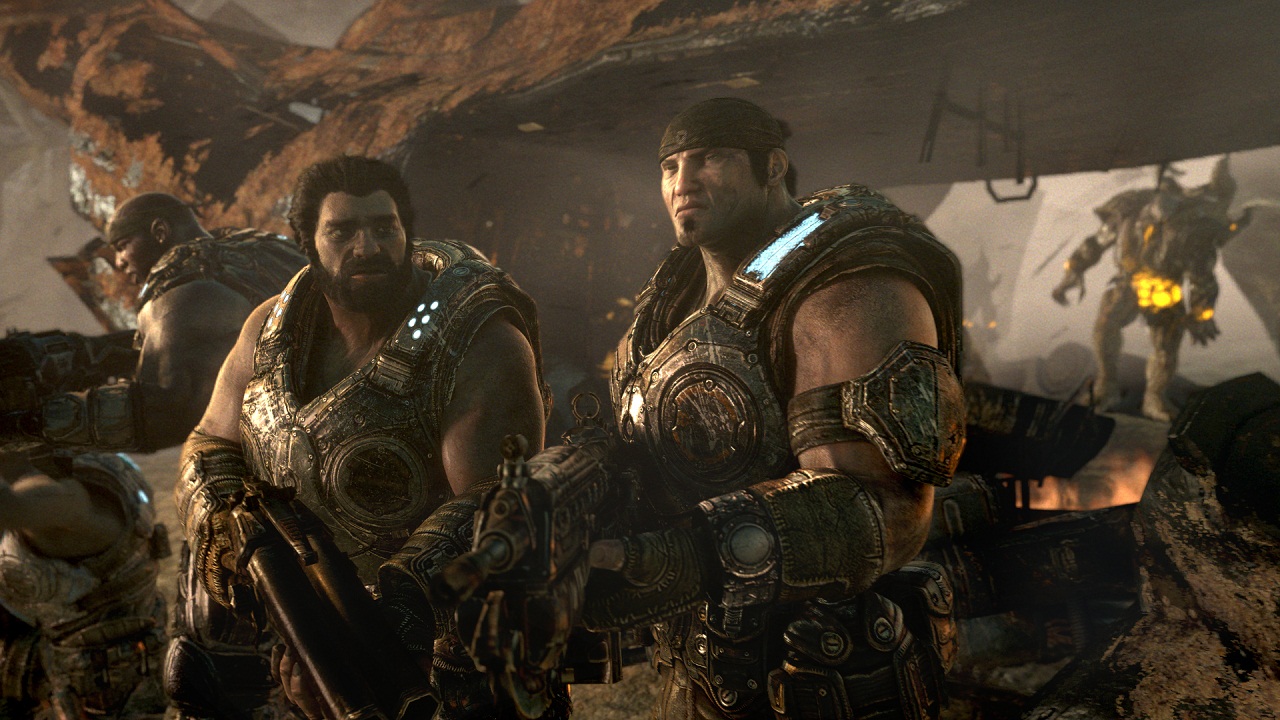
When Gears of War was first announced for the then next-gen Xbox 360 console it can be said there was almost universal acclaim for the Epic Games title. After all, not only was it the flagship title for the Unreal 3 engine, it was also one of the most brutal video games anyone had ever seen. Its 2006 release also heralded the beginning of a revolution in gameplay: the cover system, a mechanic that is utilized in many shooters today. Five years on however the Unreal 3 engine is beginning to show its age as its capabilities have been all but maxed-out and with today’s shooter being a first-person affair instead of an over-the-shoulder one it seems that Gears of War 3 may also herald the beginning of the end for the third-person shooter.
If this supposition is true then one can assume that this downfall begins with the end of a great franchise. As such, the question must be asked: has the final entry of the Gears of War trilogy earned a mausoleum or an unmarked grave in this potential graveyard-bound genre?
Click to read the full article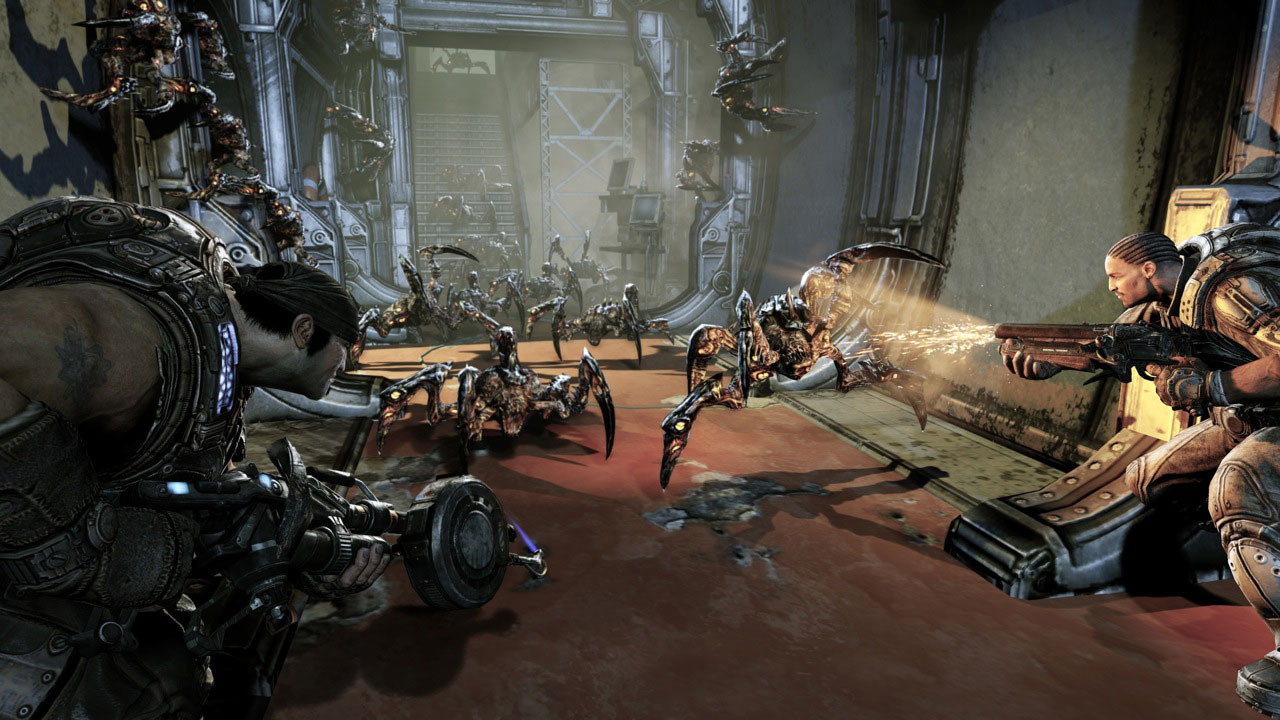
Cogs in the Machine
Gears of War’s final chapter takes place two years after the sinking of Jacinto, the last human stronghold on Sera. The destruction of the city was a blow that cut both ways as it wiped out most of the remaining Locust threat while robbing humanity of their last safe haven. Following Jacinto, the Coalition of Ordered Governments collapsed and went its separate ways, the strongest contingent putting down roots on the remote island of Vectes. The heroes of Jacinto including Marcus Fenix and his compatriots Dominic Santiago, Damon Baird, Augustus “Cole Train” Cole and Anya Stroud took this route, intent on rebuilding what was left of the human race but unfortunately Vectes wasn’t nearly remote enough to escape the fires of war. A new threat has arisen: the Lambent, Locust who have mutated after being exposed to excessive amounts of imulsion, the primary energy resource used by humans. The Lambent have taken over Vectes and driven the remaining survivors out to sea. As the Lambent threat grows stronger by the hour as well as the size of their territory Marcus and company head toward the mainland in hope of finding a safe haven somewhere where the Lambent are not.
Passing through a nearby town in Lambent territory a surprise guest arrives with even more surprising information: Chairman Prescott, the former leader of the COG who abandoned the remaining human forces six months after the fall of Jacinto. He brings a message for Marcus specifically that shocks him to his core: a call for help from his father Adam Fenix. Prior to the events of the first Gears of War Marcus and Dom broke off from a key position in the middle of battle to rescue his father only to see him crushed beneath a pile of rubble. Having deserted his position cost the COG the battle for the capital city of Ephyra and Marcus was sentenced to life in prison for his crime, leading up to the opening minutes of the first game. Certain that the message is real and that his father is still alive Marcus vows to find his father and rescue him.
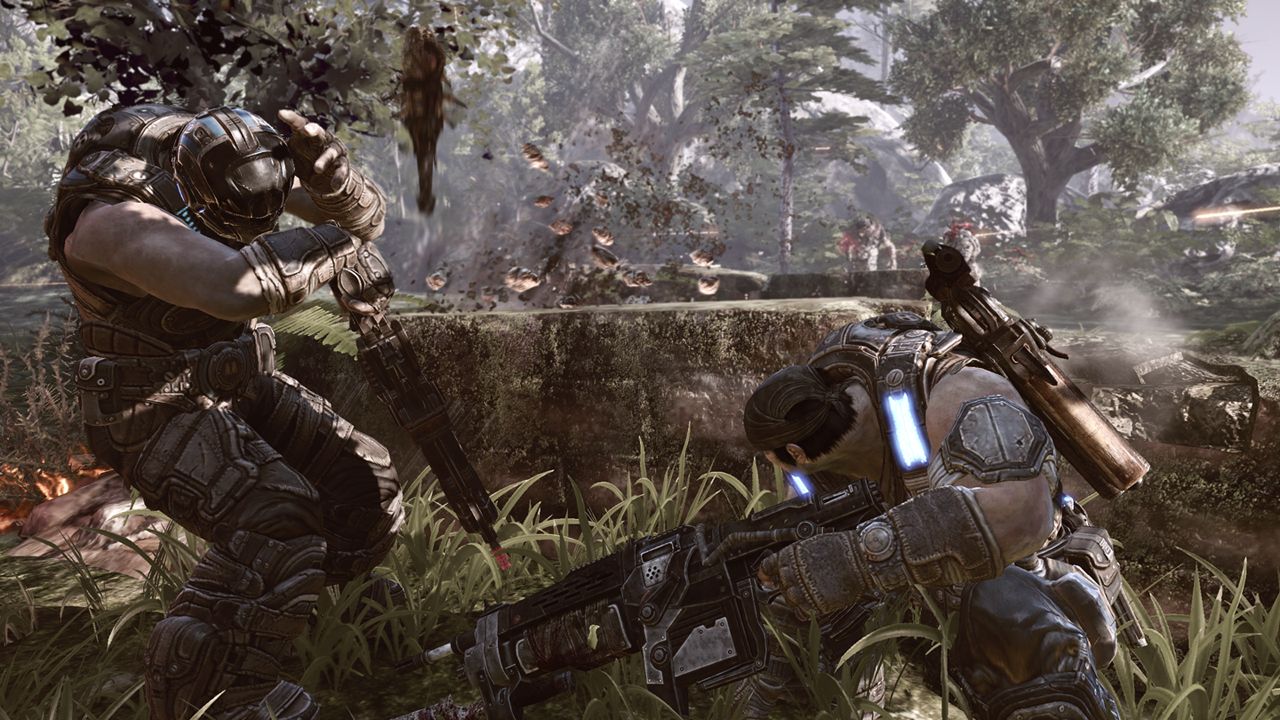
The story in a Gears of War title is one that hasn’t always been praised as high fiction. Given the nature of its presentation style with little to no backstory made available within the games themselves it is a bit of a task to actually discern anything going on during the events of the game outside of what the characters talk about and what you see in front of you. What you’d be surprised to find is that the Gears universe has a surprisingly deep history told through books and comics. What would surprise you more so is that Gears 3 is very self aware of the fact that this is potentially the final Gears of War title and as such has to wrap up the war that has stretched through fifteen years and two previous video games. You’ll notice that characters from that extended universe such a Jace Stratton, Sam Byrne and even Bernadette Mataki appear in the game and play prominent roles throughout the Gears 3 story. You’ll meet people and see places that have only appeared in print so for those who say that the Gears of War cannot deliver a strong narrative I have this reply: bite your tongue.
One item that people have argued in the past is that the marketing campaign for Gears titles have not exactly matched up to the overall tone of the series. Those poignant, emotional advertisements that do their best to sell you on how turbulent and sad the Gears universe is have never really been truthful in their representation of the far more action-oriented, hectic gameplay we all know. I’m pleased to report however that Gears 3 actually contains several moments throughout the story that evoke the emotion we associate with this commercials, one of which may even bring a few tears to your eyes, though you can be like me and blame them on emo onions cutting themselves on your coffee table when your friends ask you what’s wrong through the ear of your headset.
For those looking for longevity from the singleplayer/co-op you should take note that the campaign is actually quite a bit longer than its predecessors. Clocking in at over thirty chapters spread across five acts you can expect to take a couple afternoons finishing Marcus Fenix’s final journey, more so if you decide to up the difficulty to hardcore or even insane. Overall though, while the game’s campaign doesn’t scream for a Saturn, Hugo or even a Parsec award it is a solid conclusion to the Gears of War storyline. Plot holes are filled, characters get closure, and the future of humanity is resolved, all with little to no room for expansion past the end of the game save for campaign DLC whose placement in the game is pretty clear halfway on. It’s a nice end to a fun series and you’ll be happy to put down your Lancer for the last time as the credits roll.
Grinder? I Barely Know Her!
Going beyond the cover system and the Unreal 3 engine the biggest item Gears of War has contributed to the gaming industry is the birth of strong, online cooperative play through what would normally be a singleplayer experience. The previous two titles in the series have been a two player affair and it is wonderful to see that Epic has stepped up their game and now allows four people to play together. Other than the main character, the cast your co-op buddies will be playing changes regularly for the majority of the game and with them their loadouts as well. You can expect to be playing different characters at least once an act and while it doesn’t change the overall gameplay it does serve as a nice change of pace over the previous two games’ use of the same four characters all the time.
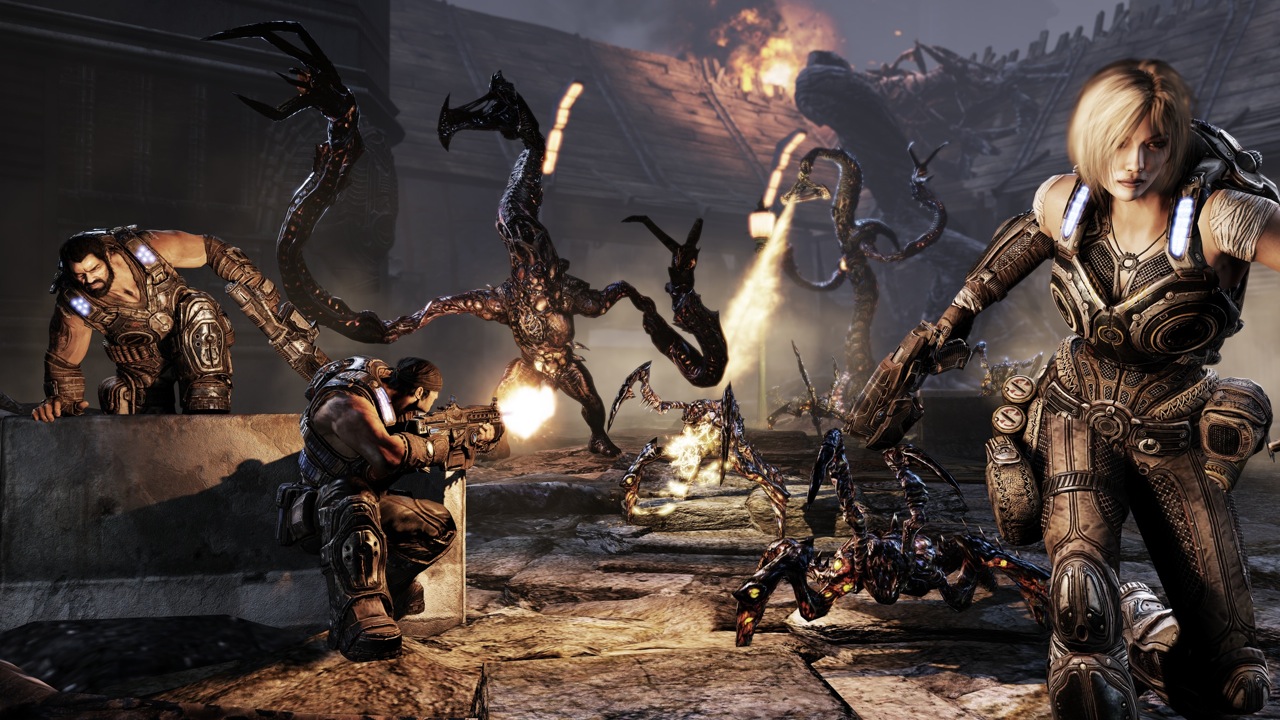
A sequel isn’t a sequel without improvements and additions and Gears of War 3 is no exception to this rule. In addition to having the traditional assortment of Gears weaponry several new additions make for an even more intense firefight. The Digger, for example, is a grenade launcher that actually travels underground and is capable of popping up above the surface behind the enemy’s cover to detonate. The Retro Lancer, a weapon alluded to quite a bit in the expanded Gears universe, has a bayonet instead of a chainsaw and fires stronger ammunition than its newer counterpart albeit at the cost of stronger recoil and a larger bullet spread. The sawed-off shotgun too is a new addition and trades off range and ammo count for a massively power short range burst that can pretty much disintegrate the enemy in the blink of an eye. The balance of some of these weapons can come into question at times but they feel right at home in the Gears universe.
The Lambent, the third faction in the new game and ultimately the biggest threat to both the Locust and humanity, are probably the biggest addition to the series. Unlike the assorted cast of subterranean beasts that populate the Locust, the Lambent serve as a twisted amalgamation of what we’ve fought against previously. Lambent Wretches annoy just as before but the addition of Lambent Drones and Polyps, the Lambent take on a Ticker, as well as the Drudge, an enemy that can transform and throw imulsion at you, all serve as deadly enemies. They all explode upon death as well though the damage from these explosions is lighter than they were in the previous two games.
Thank God I Wear a Helmet
In addition to the most refined campaign experience to date in the Gears of War series you’ll also find a plethora of different multiplayer options. This is where the meat of the Gears experience will be going forward and the variety is quite wonderful. Simply put, you’ll find something to entertain you when you want to play with other people.
Versus mode returns as it always does bringing with it classic gameplay variants such as Warzone and Execution. New to the experience however are a couple worthwhile additions to keep you occupied. Capture the Leader, a combination of Gears of War 2’s Guardian and Submission modes, plays out like a standard CTF mode with the exception being that one player on each team serves as the flag. I find myself more appreciative though of the new Team Deathmatch variant that allows for multiple respawns, something that should have been in the series from the beginning. While the selection of maps to play on are fine not one of them really stands out so one can only hope that Epic remedies this (as they always do) with DLC.
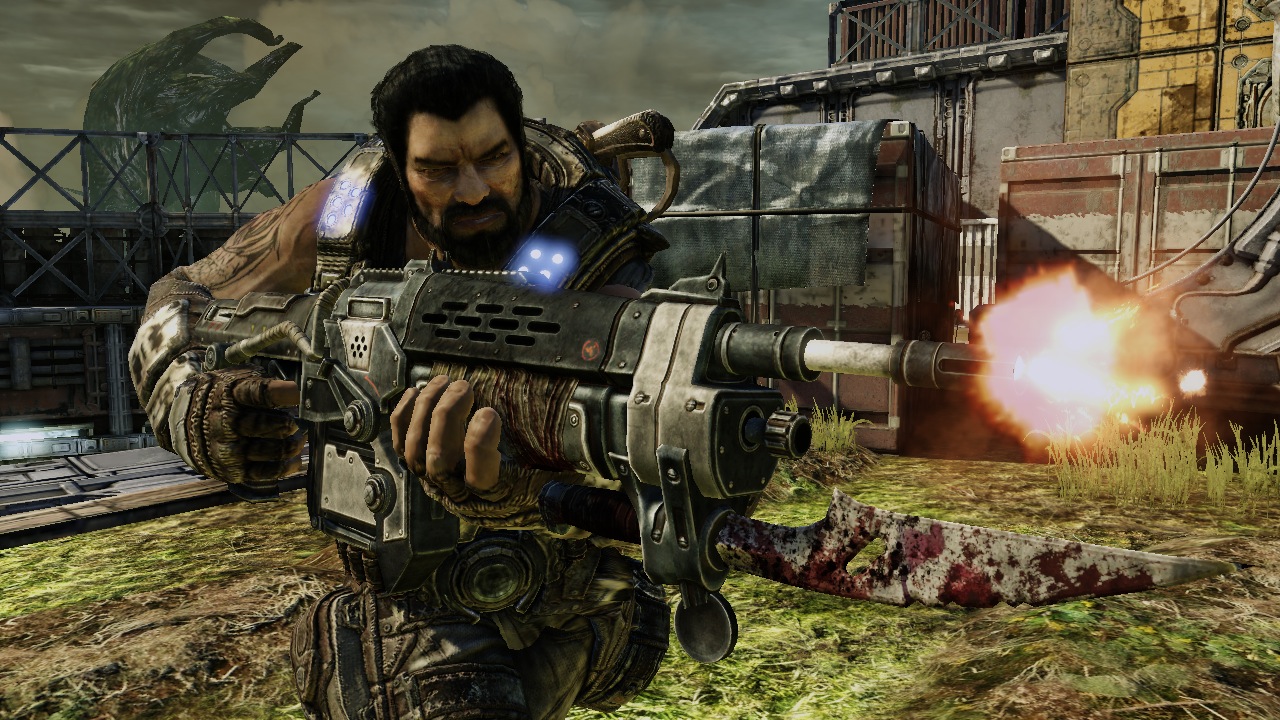
Going beyond competitive multiplayer, cooperative play comes in three distinct flavors: Arcade, Horde, and Beast. Arcade mode isn’t that different in scope from what you would assume it to be in that it is a competitive, point-gathering playthrough of four players through the game’s campaign. The Arcade mode doesn’t offer much outside of main campaign experience but it does offer replay value for those who want to avoid Versus.
Horde mode returns this year with some drastic enhancements. Much like the previous version, Horde 2.0 plays out on standard multiplayer maps against fifty waves of Locust and Lambent enemies. Unlike the previous version however you now have the ability to build fortifications to help fend off the enemy such as barriers, turrets, and even the ability to summon a Silverback mech. Every tenth wave is a boss fight this time around and has you facing off against the more prominent bosses from the entire Gears library including the Brumak, Reavers, and even multiple Beserkers at the same time. Conquering Horde mode is no easy task but with a couple hours and competent teammates it can be accomplished. The fortifications alone make Horde significantly more fun this time around and the bosses are exciting to fight against so for those looking for a fun yet potentially frustrating experience (I’m trademarking the word ‘funstrating’ right now) Horde is definitely where you want to spend most of your time.
The elephant in the room though is Beast mode, the much talked about new addition to the Gears series. Beast mode is the exact opposite of Horde wherein you play as the Locust hunting down AI humans. Beast utilizes a Counter-Strike like purchasing system for selecting your Locust and runs the whole gambit of all the infantry monsters seen in the series. Every time you kill an enemy you are awarded time and cash for your actions and continued play allows you to unlock larger, more powerful Locust to play as. The barriers and fortifications seen in Horde apply here as well so an amount of strategy is called for. Of all the Locust you can play as though I found myself having the most fun as a Ticker, the scream it emits as it sprints being one of the funniest things I’ve ever heard. Beast mode only lasts twelve rounds as opposed to Horde’s fifty but the end result is still marvelously fun and should be one of the first things you try out if you decide Gears 3 is worth your money.
Epic, like most shooter developers these past few years, intends to make sure you stick around through the turbulent October and November months and beyond thanks to a wide assortment of unlockables and events that will take place as time goes by. Medals, ribbons, titles and more can be unlocked through proper play and Epic has plans to host a series of events such as Ticker Tuesday for Horde and more. While it may not be quite enough to deter you from logging onto Battlefield 3 or Modern Warfare 3 come November it still looks to be quite fun.
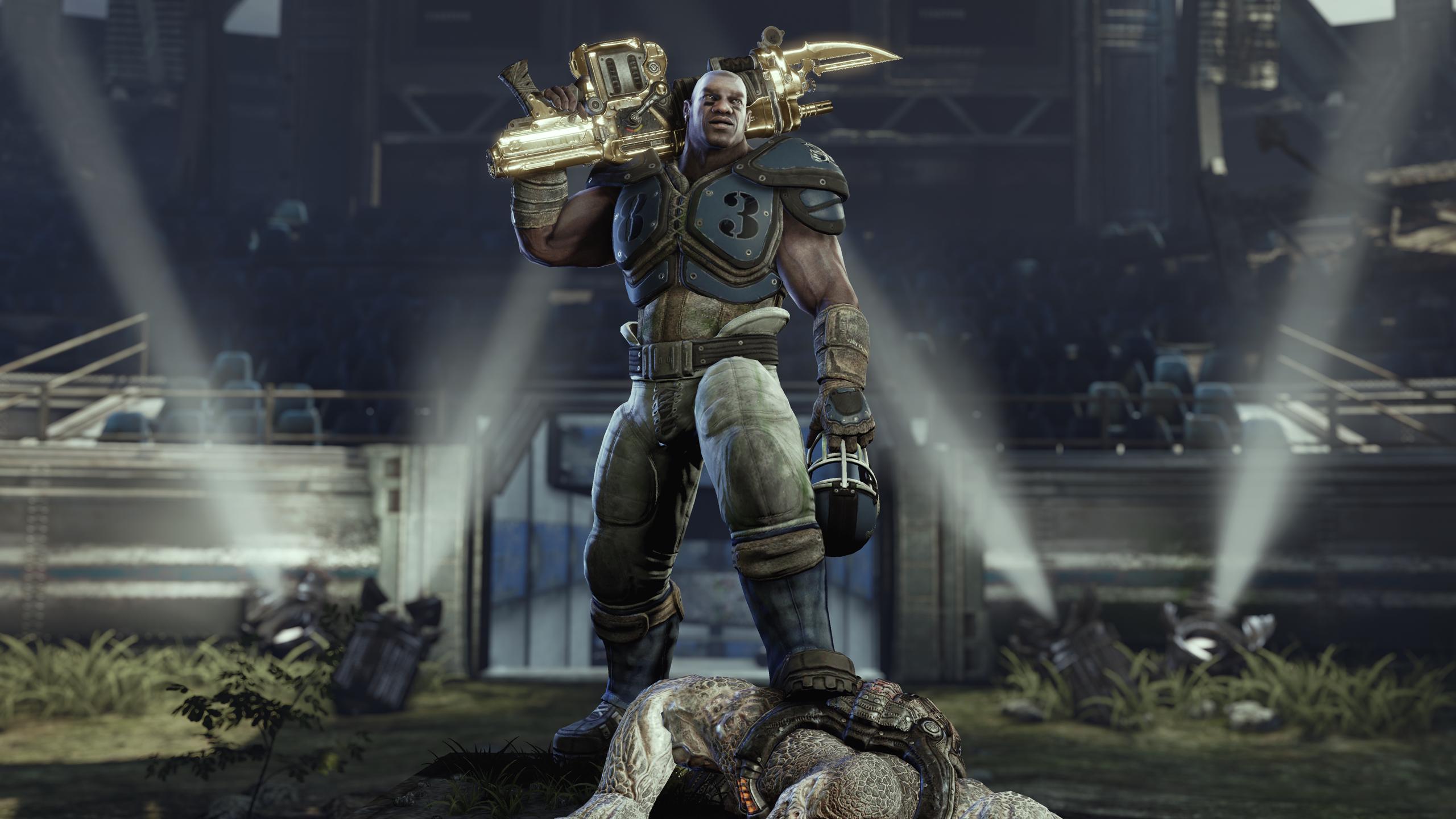
Brothers to the End
Gears of War started something five years ago and while the cover-based third-person shooter may be retreating out of the spotlight it doesn’t mean that Gear of War is falling with it. As the final entry in Marcus and crew’s story and the end of the Locust war it is a fine game worthy of your praise. With the strongest campaign to date and a bountiful selection of multiplayer modes to occupy your evenings it is hard not to recommend Gears of War 3 to your average hardcore gamer.



Third Street for Life
When we last left the Third Street Saints they were at the top of their game. After having successfully taken down Ultor (Volition’s go-to evil corporation and possible series tie-in to Red Faction) and eliminated the major competing gangs in Stillwater the boss (you), Johnny Gat and Shaundi have become international celebrities. The Saints can get away with practically anything and with the power of Ultor’s media division behind them everything from merchandising to even major Hollywood films are being made about them. No one can stop them or, at least, that’s what our “heroes” thought.
During what was to be a routine “for fun” bank robbery the tables are turned on the trio as the seemingly innocent tellers draw submachine guns on them. After a daring attempt to hijack the vault with a helicopter fails they are captured and awaken on a jumbo jet owned by Philippe Loren, leader of an international criminal organization known as the Syndicate. The Syndicate is moving into Stillwater and the three are offered their lives in exchange for a huge cut of the Saints’ profits. Naturally, our heroes decline the generous proposal and one explosive, bullet-filled escape later we find ourselves in Steelport. As dirty a city as Stillwater was, Steelport is a cesspool in comparison as three gangs run the town under the umbrella of the Syndicate. Out for revenge, our heroes must find new allies and do what they do best if they want to take over the city.
If you thought taking over the city of Steelport would be as easy as it was to control Stillwater you’ll find this will be no easy task. Three rival gangs that inhabit this burg: the Luchadores, a gang of Mexican wrestlers; the Deckers, a team of nigh emo cyberpunks; and the Morningstar gang headed up by Philippe Loren and his evil Asian twin guards Viola and Kiki. Each occupy a section of the town and have missions specific to them (no missions seem to correspond with more than one gang). Just like the previous titles as well there is no required order needed to take them on in so you can handle them in almost any order you wish throughout a large part of the game.
To aid you on your conquest you have a cast of old and new allies. This troupe of characters that you interact with is certainly an eclectic bunch but, then again, when has Saints Row not gone for over-the-top? Shaundi, the murderous temptress with a passion for explosives as well as Pierce the wisecracking minion are present throughout this tale of street revenge but new allies appear to aid you in this new town. Oleg Kirrlov, a giant of a man, becomes your ally after the Syndicate decides to create a clone army based on him. Angel De La Muerte, voiced by none other than Hulk Hogan, is an ex-Luchadore and will aid you in your fight to wrestle control over their territory. Kinzie Kensington is a former FBI agent who has it out for the Deckers. Zimos, who wants payback against the Morningstars, is probably the funniest of the new supporting cast as he has a microphone cane that auto-tunes his tracheotomied voice box. Each one is quite entertaining but Zimos is easily the one you’ll want to hang out with the most.
Who Wouldn’t Want to be Johnny Gat?
Much like the previous games in the series, Saints Row The Third continues in the tradition of waging a turf war against rival gangs with the added goal of wiping out the criminal organization that owns Steelport. The game also follows in the tradition of starting you out with nothing and forcing you to work your way up, putting you through tutorial missions initially to set up your first cribs as well as each type of activity you can participate in. While the variety of activities you can take on is small (on the same order as the previous two games) it is a varied enough affair to not have you coming back to them wondering what you need to do.
Returning to Saints Row The Third are several classic activities as well as a host of new ones. Snatch, the prostitute capture activity as well as Insurance Fraud, Trail Blazing and Mayhem return from Saints Row 2. Four new activities, Tank Mayhem, Guardian Angel, Trafficking and the curiously named Professor Genki’s Super Ethical Reality Climax bring the count up to twelve. Tank Mayhem plays out just like a standard Mayhem event albeit with, well, a tank and both Guardian Angel and Trafficking have you escorting someone throughout Steelport. Professor Genki’s event however is an entirely different animal all together. A Japanese game show, you are subjected to a Smash TV-esque point grinder where you have to shoot enemies dressed as mascots (furries, beer brands, what have you) as well as signs that liter the rooms while avoiding walls of fire and electricity. The end result is hilarious and really does a great job of spoofing the source material it is based on. If anything, this should be the first activity you complete all the way through.
One thing about Saints Row you will notice is that everything from the previous games has been upgraded, an enticing fact considering that Saints Row 2 was already a terrific game. The character creation system is even more powerful than before and rivals that of even Bethesda and Bioware titles. This customization factor also applies to vehicles and your gang, albeit at a smaller level. Weapons can also be upgraded to outlandish levels (visually anyway) so it is worth your time to spent that hard earned cash.
Outlandish is probably the best word to describe the Saints Row series and The Third is no exception. Nothing is sacred in the Saints’ tale of urban conquest and every single exotic taboo, fetish and otherwise deviant activity is either joked about, referenced, or utilized somewhere in the game. You name it, there’s a joke. Heck, you even visit a BDSM club early on in the game to rescue a principle character which ends with one of the most hilarious (and wrong) chase sequences ever conceived of. Volition certainly pulled out all the stops on this one.
Cooperative play, something that has yet to be implemented to its logical extent in a lot of Saints Row’s main competition, is back and while it is just as fun as you remember one new item is probably the most outlandish Whored Mode. Yes, you read that right. A take on the now classic horde mode, Whored has you facing off against increasingly harder waves of gimps, prostitutes, zombies and others using weapons such as the Fart in a Jar (quite possibly the deadliest grenade ever made), the Penetrator rubber dildo bat (I can’t believe I just typed that). Despite its raunchy nature it is surprisingly fun and extends the game a significant bit beyond the singleplayer experience.
Strapping It On
A lot can be said about Saints Row The Third but the only word that wouldn’t be used to describe it would be ‘subtle.’ Volition has refined their crime-riddled sandbox series to a fine point with The Third and it is a must have for series veterans as well as those who wanted GTA to have a better sense of humor. It definitely isn’t for everyone and much of its raunchy nature could be an automatic turn off for prospective gamers looking for something wholesome but if you are looking to test the limits of taste and have fun the whole time through you’d be hard pressed not to pick this one up.